In this article, we’ll help you discover the best things to do in Amman, Jordan. You’ll find the best activities & attractions in Amman, where to eat, where to stay and so much more. Plus, we’ll give you 1-day and 2-day Amman itineraries to make the best of your time here.
Amman. Jordan’s capital city. An ancient place with a rich history, a vibrant scene and beautiful landscapes… yet most people skip it during their Jordan vacation.
It’s too bad that so many treat Amman as a quick stopover. It’s often seen as just a place to land before heading off to Petra or Wadi Rum. But the capital is so much more than that!
If you spend even a day here, you’ll quickly realize this city has so much more to offer. With its ancient history, its buzzing neighborhoods and friendly locals, and a growing creative scene, Amman is the kind of place that will surprise you in the best way possible.
We didn’t expect to love Amman as much as we did, but it completely won us over. We spent days walking around its many neighborhoods. We watched the sun set over the Roman Citadel. We reveled in the maze of souks, taking in the tastes and scents.
Sure, the city has a ton of history – it’s been around longer than most other places in the world. But you can also find amazing street art, cool cafés and vibrant culture around every corner.
In this guide, we’ll share the best things to do in Amman, whether you’re here for one day or two. From iconic landmarks like the Citadel & Mosque to hidden gems like the art galleries and street art walks, these itineraries help you see a side of the city that most travelers miss.
So if you’re curious about what makes Jordan’s capital truly special, keep reading. We’re ready to show you why Amman deserves a spot on your travel list.
So let’s jump right in and discover everything Amman has to offer.
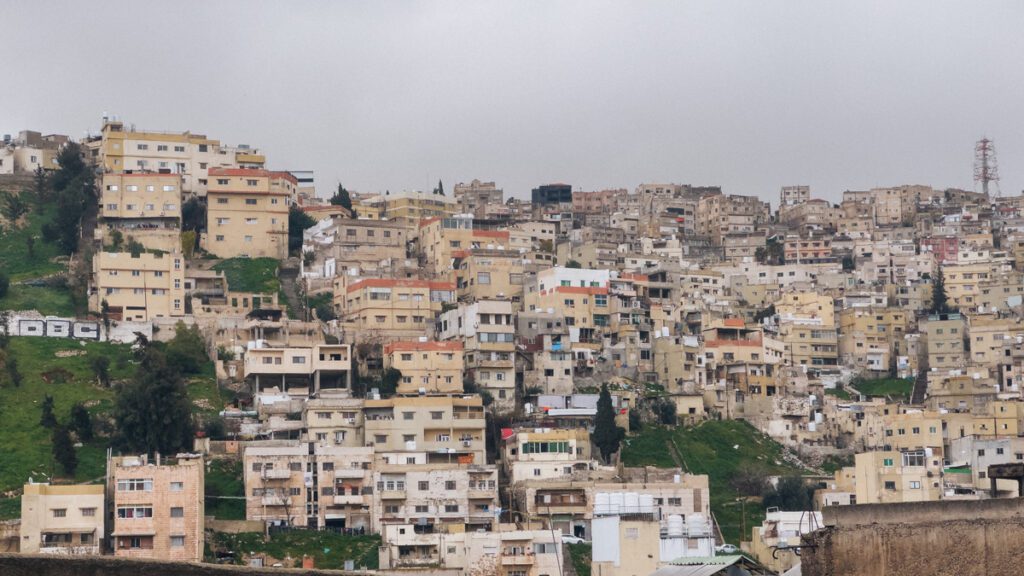
This article may contain affiliate/compensated links. For more information, please see our disclaimer here. We take all the efforts necessary to ensure the information included in this post is accurate, correct and current, sometimes, things just change! Travel information like opening hours, business operations and prices may change. If you find anything in this post that is incorrect or outdated, please let me know in the comments so I can update it for other readers. Cheers!
We love helping you plan amazing trips. If you need any of these services, consider booking them through our affiliate links. Without costing you anything extra, you will be helping support us so we can continue to write these blogs for you.
We thank you again for your continued support.
🏠 Find the perfect place to stay with Booking.com
✈️ Get the cheapest flights with Skyscanner
🚣 Book your favorite activities with Viator
💻 Make sure you have everything you need for your epic trip by checking our store on Amazon
Table of Contents
A quick overview of Amman, Jordan
Before jumping into the best things to do in Amman, we want to share a little bit more about the capital city of Jordan. This is the best way to truly grasp what makes this ancient city so unique, and to understand its current state.
Amman has a rich and diverse history that spans over several millennia. It’s one of the oldest continuously inhabited cities in the world and you can trace its origins back to the Neolithic era, around 8500 BCE. They have discovered evidence of early settlements in the surrounding area to confirm this.
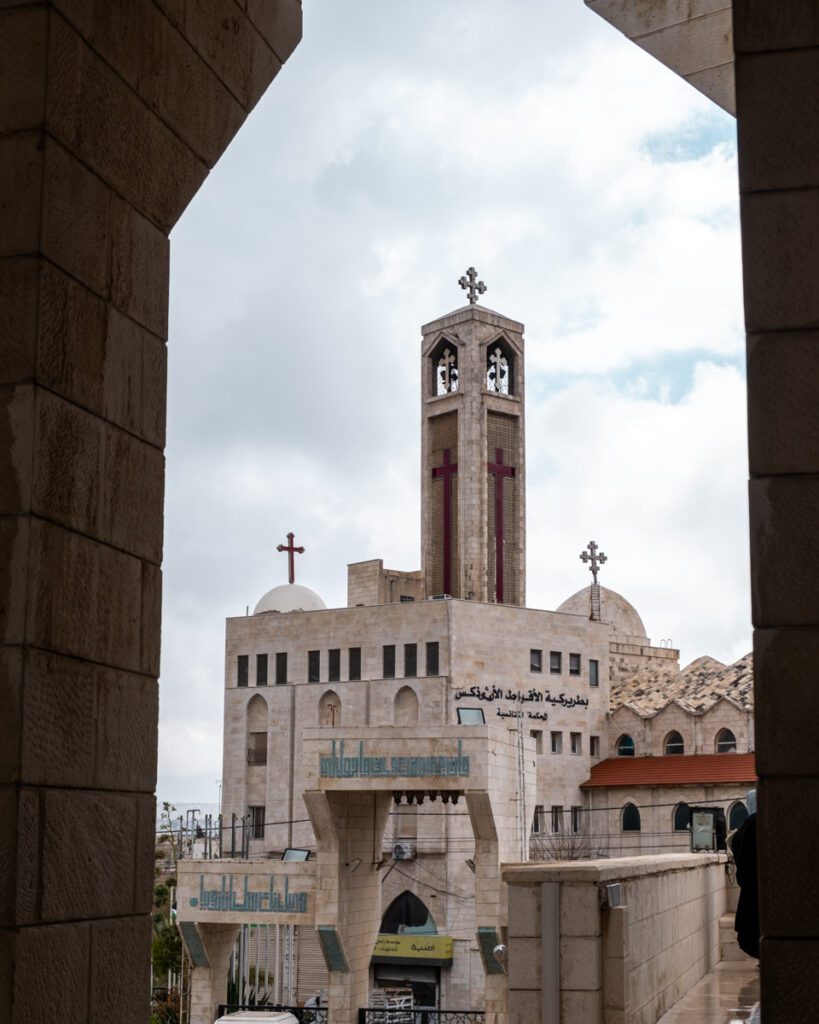
During the Bronze Age, Amman was part of the Ammonite kingdom and it flourished as a significant center in the region. Later, after Alexander the Great’s conquests, the city was renamed Philadelphia and thrived as an important commercial and cultural hub.
We were quite surprised to see this name on many of the information slabs at the ancient sites. This is also why much of the architecture in Amman has a Greek look and feel to it.
The Romans later incorporated Philadelphia into their empire. Today, you can still see many of the impressive architectural beauties they left behind, like the Roman Theatre and the Temple of Hercules – all part of the attractions in Amman you have to see.
With the rise of Islam in the 7th century CE, the city’s name changed to Amman, and it became part of the Umayyad Caliphate. During this period, they started building palaces, mosques, and other Islamic monuments that you can still see today.
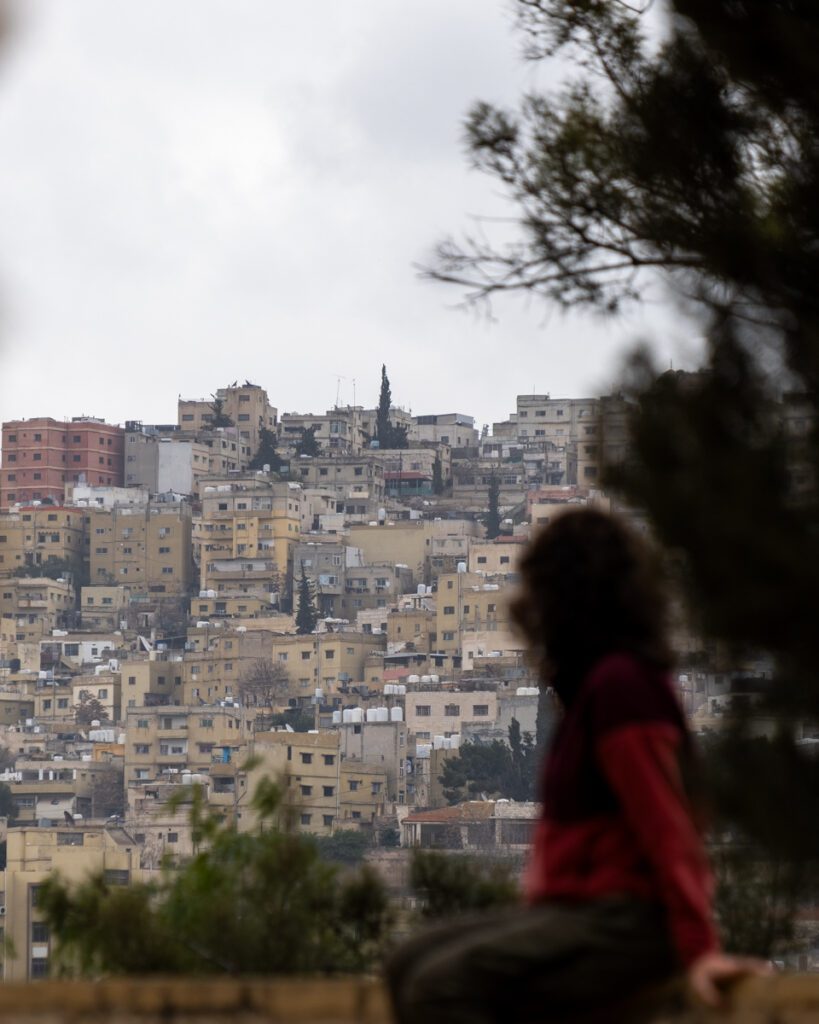
With the passing of time and different periods, Amman experienced shifts in power between Muslim and Christian forces, which is why you can still find Crusader fortifications, churches and Ottoman-era buildings today.
Amman became the capital of the newly established Hashemite Kingdom of Jordan in 1946. It underwent rapid urbanization and development, which you can definitely feel when you visit the city.
Today, Amman stands as a vibrant metropolis, where its rich history is reflected in its archaeological sites, ancient landmarks, and diverse cultural heritage. It’s a fascinating destination to add to your Jordan itinerary!

Quick facts about Amman
Here are the essential things you need to know about Amman:
- Population: Amman is home to 4 million people. That’s almost half of Jordan’s population
- How long to spend in Amman? If you can spend at least 1 full day and 2 nights, you’re golden! If you only have 1 day, check out this tour showcasing the best food and highlights of the city.
- Easiest way to get to Amman: From the Queen Alia International Airport, the most convenient way is with a private transfer.
- Weekends in Amman: In Jordan, the weekends are on Friday and Saturday. This is when businesses and sites might be closed and when you’ll find many locals exploring the attractions. If you want to avoid crowds, skip the main sites on this day
- Highlights: The Roman Citadel and the Roman Theatre are must-sees in Amman
- Where to shop? The lively Souk Al-Sukar is perfect for spices and food souvenirs
- Take in the arts: Amman has a notable arts scene & incredible street art. Check out Funar al Dalat, one of our favorite stops in Amman
- Religion: Jordans & Amman are primarily and majority Muslim. The King Abdullah I Mosque is open to visitors
- Eat: Bayt Sara for vegan meals. Hashem for traditional Jordanian food. Habiba for sweets. Or, you can join a cooking class here
- Where to stay in Amman: Stay in the city center. We highly recommend the Sandra Hotel – amazing breakfast included and convenient location
- Day trips: Stay in Amman and head out on day trips to Jerash, Umm Qays, As-Salt, Madaba, or the Desert Castles
The best things to do in Amman
In this section, we’ll tell you about the top attractions in Amman, as well as some important tips to help you make the best of your time here. Some of these, we wish we knew before exploring the city.
These sites are not placed in any order, and please don’t take this list as a checklist of everything you need to see and do in Amman. As with all our articles, we want to give you as much information as possible to help you make the best decisions for you, your budget, your interests and your timeline!
TOP TOURS IN AMMAN
If you want to make the most of your time in Amman, here are some of the best rated tours available:
– Best Food Tour
– Best Walking Tour
– Best Day Trip
– Best Cooking Class
1. Discover the Citadel, a must-see in Amman
The Roman Citadel is hard to miss. It’s the top attraction in Amman and it sits atop the highest hill, one of the original seven hills of the city. Regardless of how long you stay in Amman, this should be one of the first sites you visit.
The Amman Citadel is also known as Jabal al-Qal’a, has a rich history that spans over several millennia. You can easily spend 2-3 hours here, if not longer, as there’s also the Archaeological Museum to visit.
As we mentioned, Amman is one of the oldest continuously inhabited places in the world. And the Citadel is a part of this history – it has been inhabited since the Neolithic period. Since it sits atop a high hill, it’s an important strategic location for various civilizations like the Ammonites, Greeks, Romans, Byzantines, and Umayyads. Each one left a mark on the ruins left there today. Plus, that elevated vantage point gives you amazing views of the city!
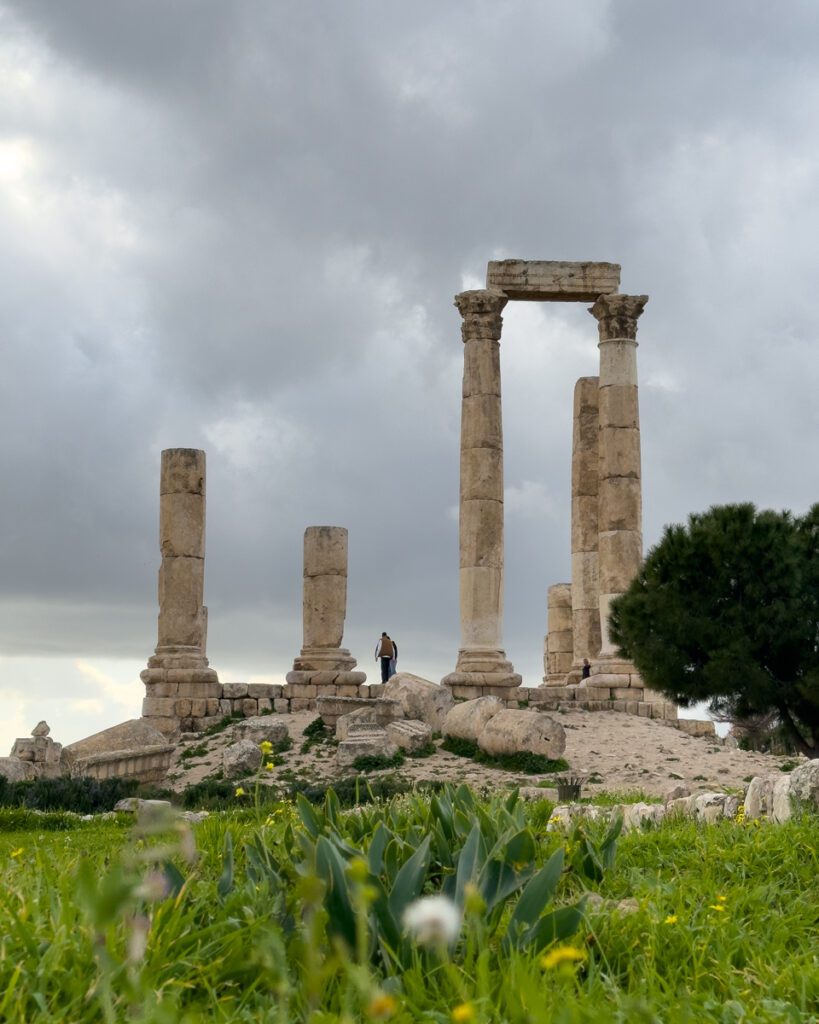
The highlights of the Amman Citadel
Today, there are quite a few highlights you can visit in the Amman Citadel. These are the top ones:
The Temple of Hercules.
This is the most prominent structure you’ll see at the Citadel. Not much of it is left today, but you can imagine what it looked like back in the day! It was believed that the temple was built during the Roman period. If you’re looking for a great photo op, this is the place to do it, especially during sunset when the sky is lit up behind the main arch. You can also sneak behind one of the other nearby structures to get a different framing.
The Umayyad Palace.
This blue-domed structure is one of the few to remain standing today. The Palace complex dates back to the Umayyad Caliphate of the 7th-8th century CE. It consists of a series of courtyards, living quarters, and audience halls which are laid behind the entrance building. From the palace, you have stunning views of downtown Amman and the surrounding hills. Make sure to spend some time exploring this area. We didn’t have a chance as guards started ushering people out 30-45 minutes before closing.
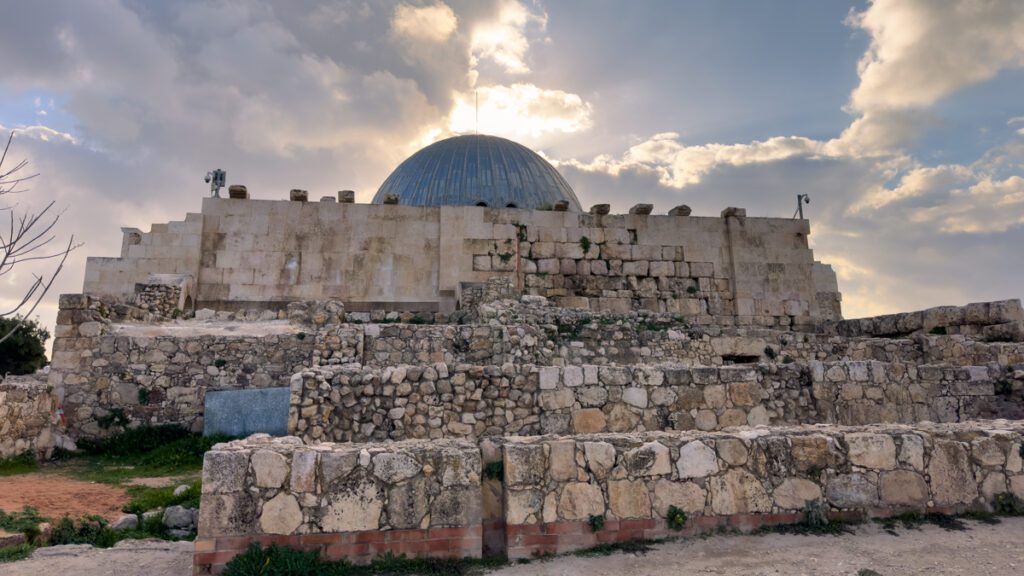
The Archaeological Museum.
Located within the Citadel complex, the Amman Citadel Archaeological Museum showcases artifacts and relics discovered during excavations of this site. At the museum, you’ll get more insights into the various civilizations that lived in the area, with findings dating back from prehistoric times to the 15th century. You’ll need about 15-30 minutes at the museum.
The Byzantine Church.
Not much is left of it today, but you can still see remnants of a Byzantine church at the Citadel. You’ll be able to spot mosaic floors and architectural fragments. The church dates back to the Byzantine era (4th-7th century CE) and offers a little glimpse into early Christian history in the region.
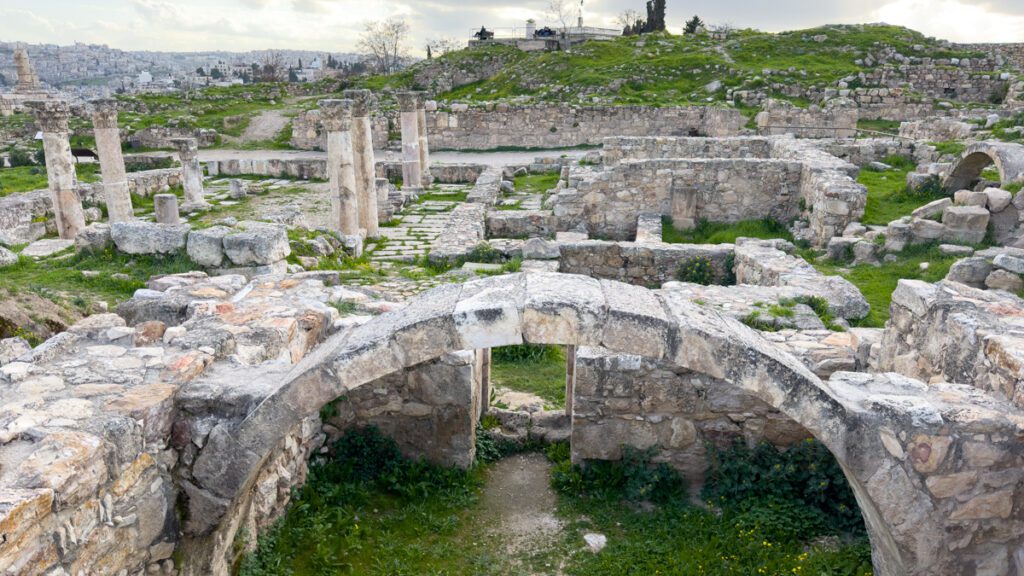
Top tips for visiting the Amman Citadel
Take the time to walk around the Citadel. Stop and enjoy the view from all the different areas. It’s a big site, so give yourself enough time to soak in the history while still enjoying the present.
The best times to visit are at opening, when you’ll have fewer crowds, or closer to sunset, when you’ll have beautiful light. Avoid being there in the afternoon sun, especially in the scorching hot summer – there isn’t much shade here, so you’ll be out in the sun for your entire visit.
Make sure you check the opening hours as they vary in the summer and winter. We made this mistake (we trusted Google) and our visit was cut short. Note that guards start ushering people out about 30-45 minutes before closing time.
Wear comfortable shoes that offer good support. The ground is uneven in many different parts. Also, wear protective clothing to shield yourself from the sun. And bring water with you if you plan on staying for a while. There’s also a little café and shop where you can get treats and souvenirs.
ABOUT THE AMMAN CITADEL
Location on Google Maps
Hours of operation:
– Jan 1 to March 31: 8 am to 5:30 pm.
– April 1 to May 15: 8 am to 7 pm.
– May 16 to August 31: 8 am to 8 pm.
– September 1 to October 31: 8 am to 6:30 pm.
– November 1 to December 31: 8 am to 5 pm.
Entrance fee: 0.25 JOD for locals. 3 JOD for foreigners
Included in the Jordan Pass
How long to spend here: 2-3 hours
2. Visit the beautiful King Abdullah I Mosque, an iconic landmark in Amman
The King Abdullah I Mosque is an active mosque and it’s also a significant religious and cultural center in Amman, even today. Luckily, it’s open to visitors, so if you have the time, it’s a great place to immerse yourself in the culture. You can spot it sitting atop one of the hills from different vantage points around the city.
The mosque, also known as Al-Husseini Mosque or simply King Abdullah Mosque, was built between 1982 and 1989. It was built to commemorate the centennial of the late King Abdullah I, the founder of modern Jordan.
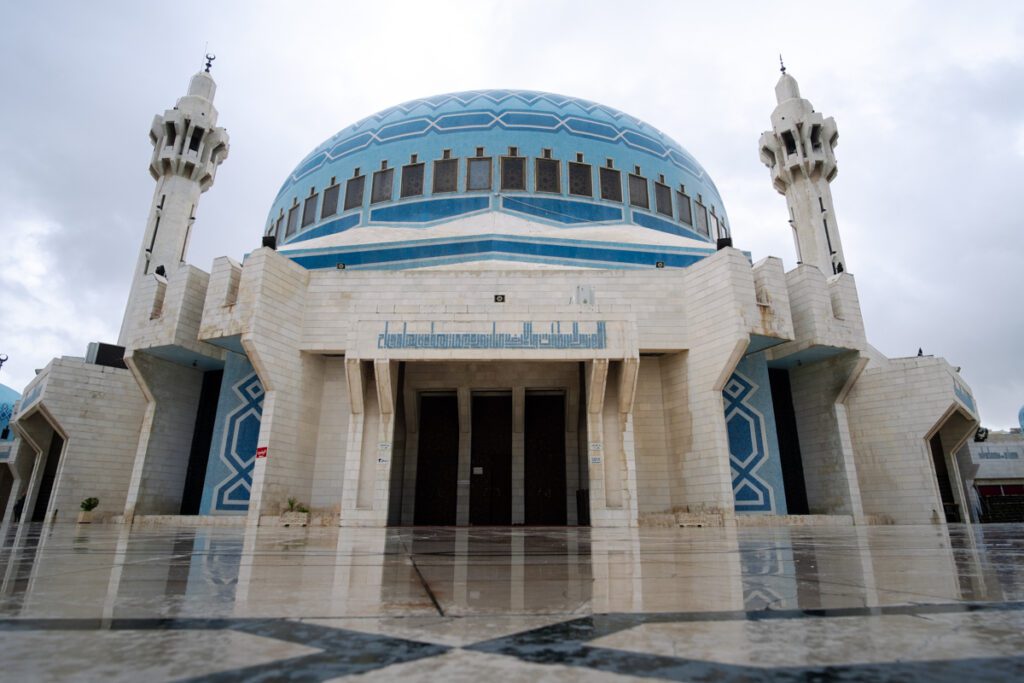
This mosque is so beautiful blends modern and traditional Islamic architecture with influences from Jordanian and Mamluk styles. This mix makes it more unique and beautiful. Throughout the mosque, you can also admire exquisite examples of Islamic art, including intricate geometric designs, floral motifs, and Arabic calligraphy inscriptions from the Quran.
The property itself is beautiful, from the gardens to the courtyards to the main prayer room. You can find intricate patterns adorning the different parts of the building, minarets and domes. Inside, you have beautiful imposing chandeliers that are hung from the ceiling. On busy prayer days, you can fit 7,000 worshippers in the mosque.
You need to pay 2 JOD to visit the mosque. For men and women, you should dress modestly. Men will need to have their shoulders and knees covered, while women will be given a hooded gown to wear that covers their hair. Before entering the prayer room, you will need to remove your shoes.
Avoid going during prayer time so you don’t disturb the worshippers. We have to admit, though, that we were terrible at this. Seems like we were constantly in a mosque during prayer time! An important tip would be to check prayer times online before going. Simply google them.
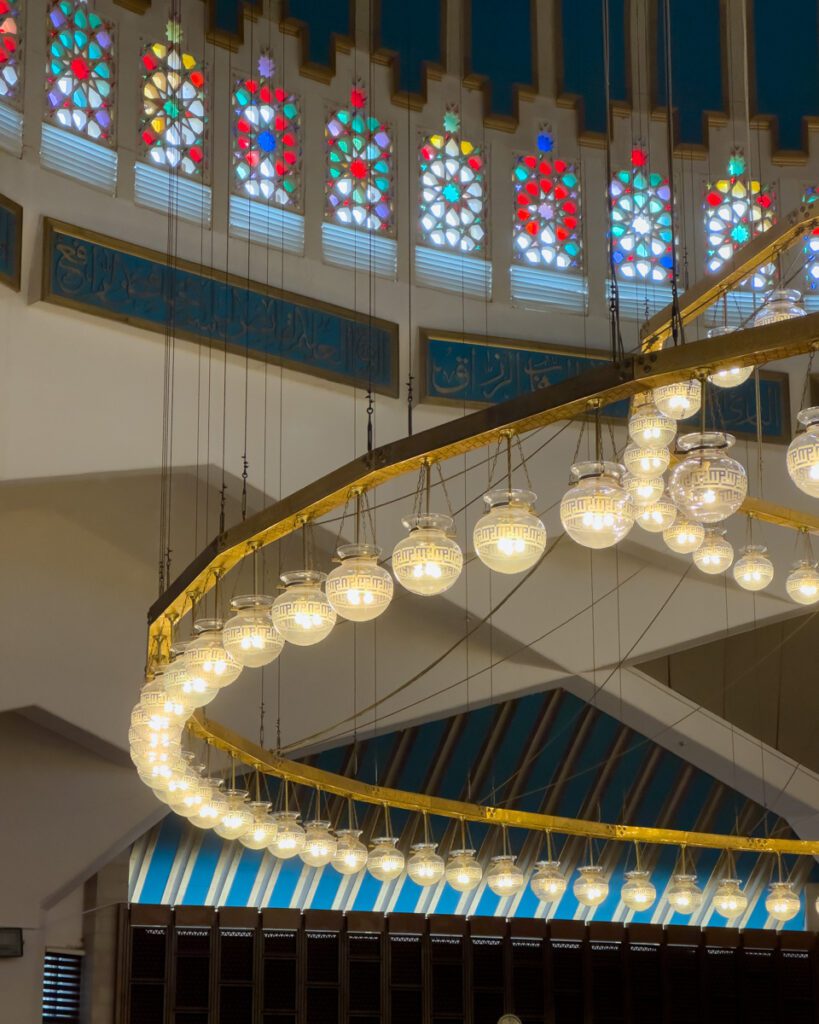
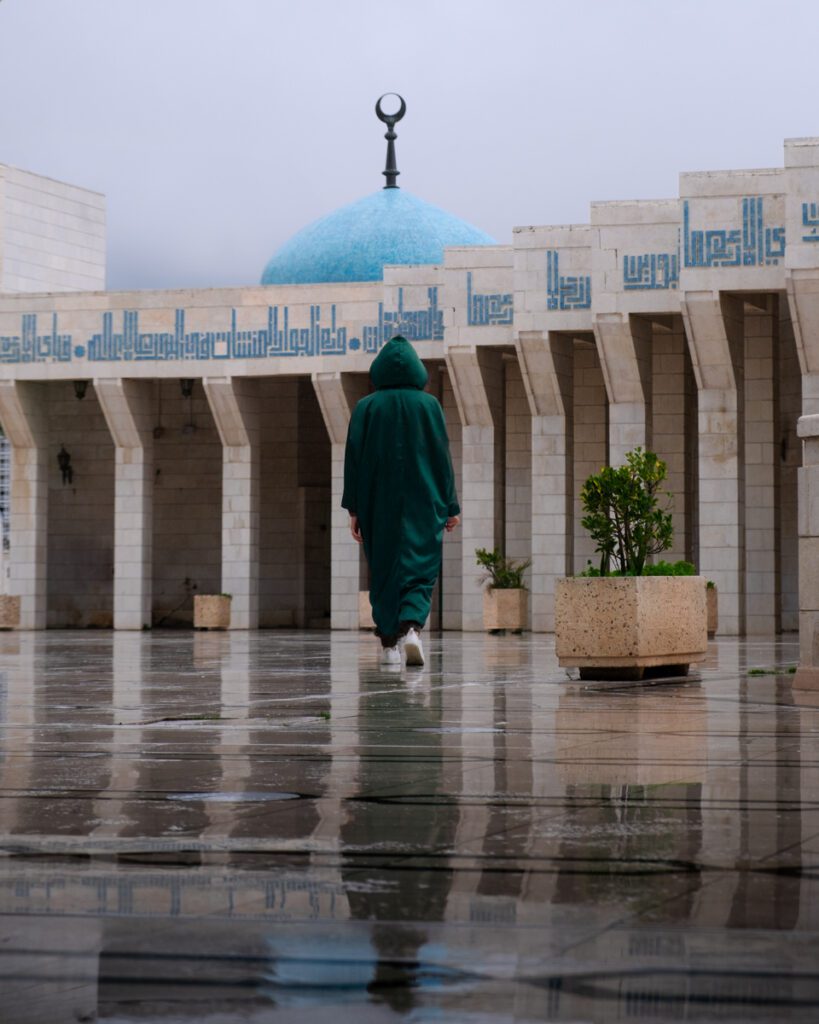
After you visit the mosque, you can pop into the little Islamic Museum. Here, you’ll find some of King Abdullah’s belongings, as well as significant pieces of Jordan’s Islamic history. You can also visit the bazaar they have downstairs. You’ll find tons of different handcrafts from jewelry to pottery to chess and backgammon sets and much more.
You’ll need about 30-45 minutes to explore the property. However, it should be noted that women will have a lot fewer places they can access than men.
ABOUT THE KING ABDULLAH I MOSQUE
Location on Google Maps
Hours of operation: You can visit the mosque when it’s open every day until 10 pm, but we recommend sticking to reasonable hours, from 9 am to 6 pm.
Entrance fee: 2 JOD for foreigners. Free for muslim worshippers.
Not included in the Jordan Pass
How long to spend here: 30-45 minutes
3. Take in the arts at Darat al Funun, one of the best things to do in Amman
As we mentioned, Amman has a great art scene. You’ll notice the street art walking around the city, and you’ll soon realize that there is a district dedicated to the arts here. This gallery may be a bit off the beaten path, but if you have the time, and you want to immerse yourself in the artistic heritage of Jordan, and the Arab world, Darat al Funnun is a great place to go.
Founded in 1988 by the Abdul Hameed Shoman Foundation, Darat al Funnun is a non-profit organization dedicated to promoting arts, culture, and education in Jordan. The art gallery is free to visit and is housed in 6 different buildings that make up this beautifully restored 1920s villa. The gallery is located in the Jabal Al-Weibdeh neighborhood of Amman, where you have amazing views of the city’s skyline.
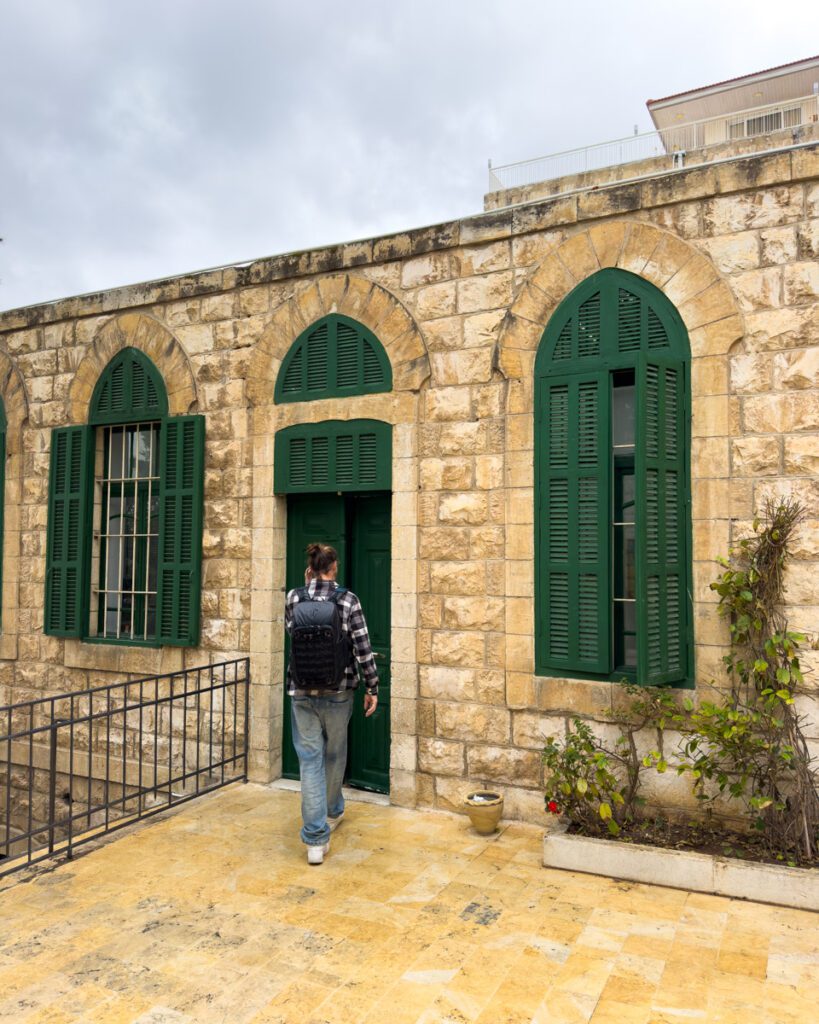
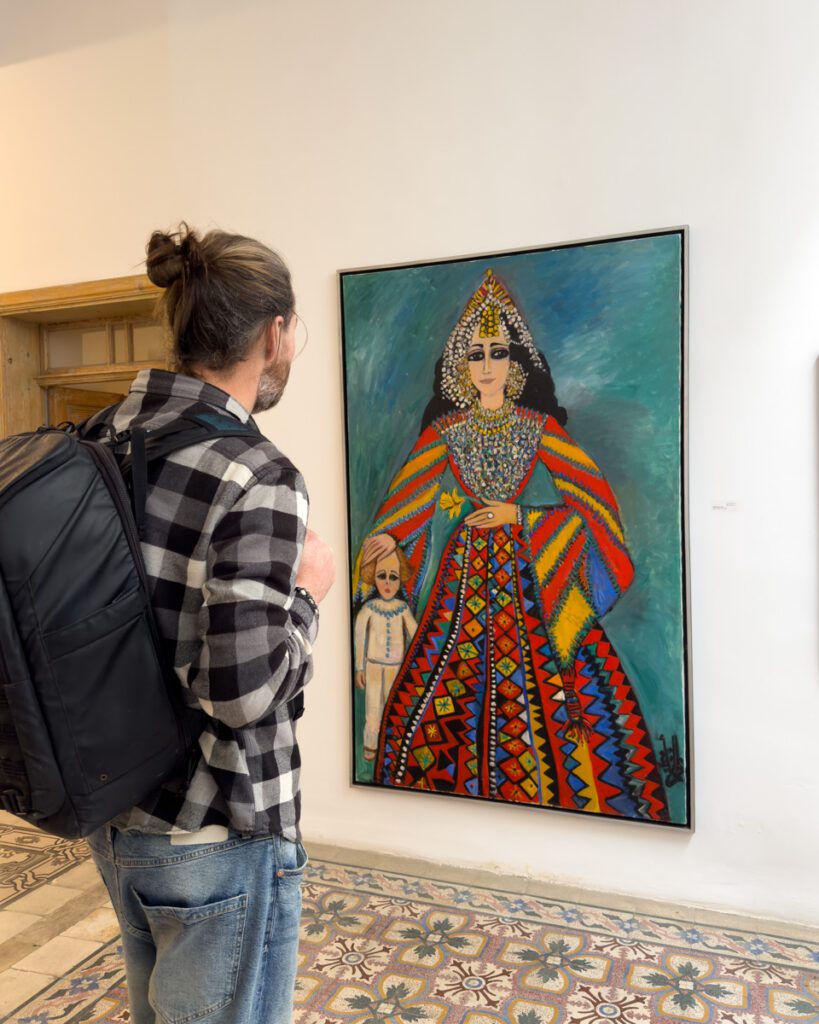
Darat al Funun is a hub for contemporary Arab arts. They host exhibitions, artist residencies, workshops, lectures, and cultural events throughout the year. While we were visiting in March 2024, they dedicated their exhibition to Palestinian artists as a way to stand in solidarity with the people of Gaza. Their exhibitions cover all sorts of mediums, from painting, sculpture, photography, video art, to installations.
Make sure you look at their programming as they often host cultural events, like film screenings, music performances, poetry readings, and panel discussions.
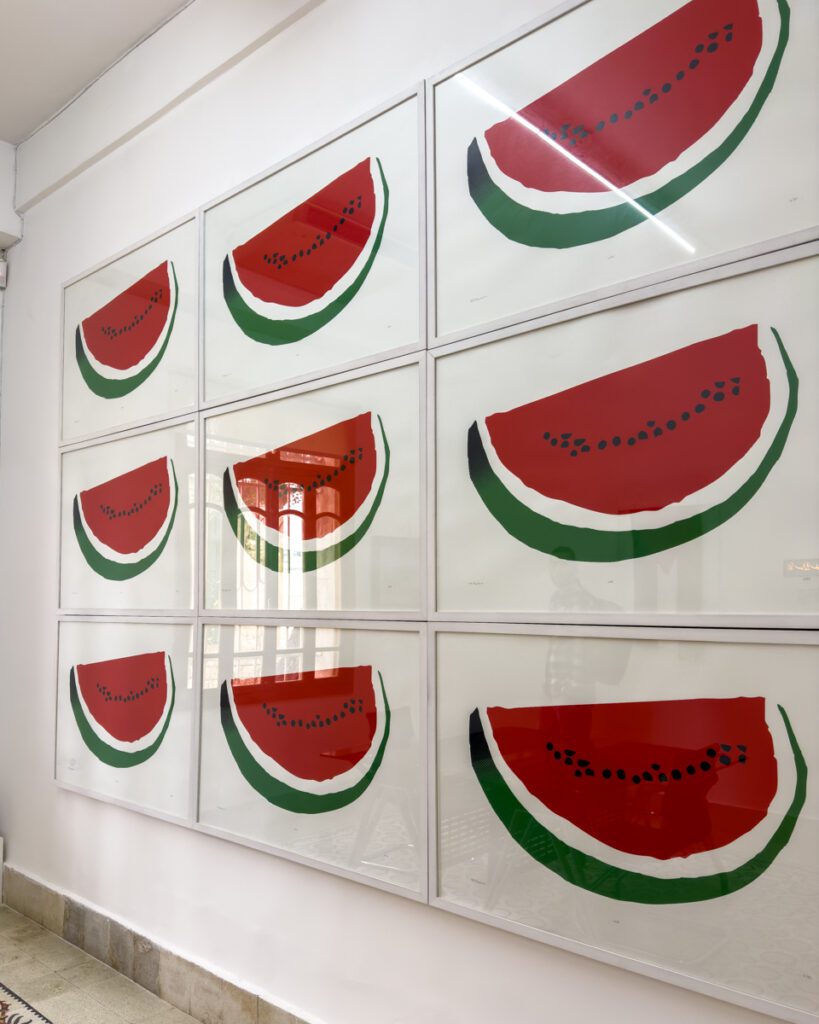
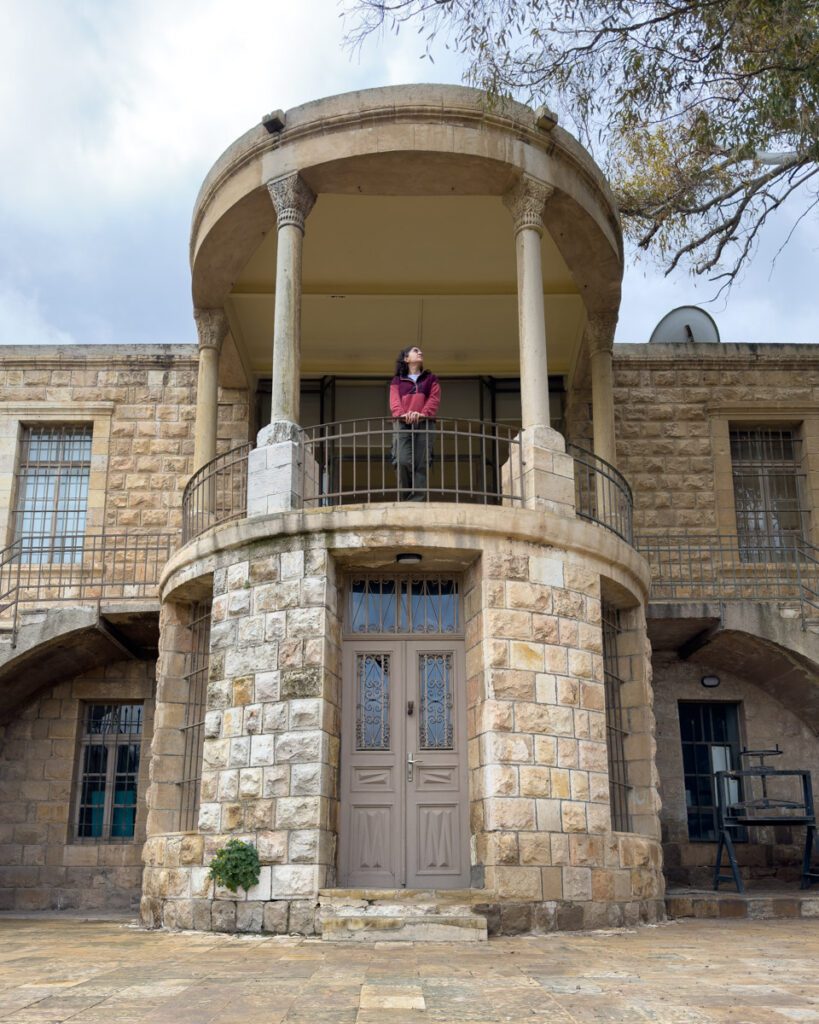
While on the property, make sure you walk around to all the different parts – you’ll even find a courtyard with some columns in ruins. Plus, you can read more about the restoration of the property. We even had a chance to meet one of the men who helped restore the villa to its current beauty. He showed us many pictures of him working there. Although we had a slight language barrier, we still understood the importance this place holds for many locals of Amman.
You can easily spend 2-3 hours here, especially if you sit in their cafe to enjoy the view and grab a bite. If not, this is a great place to stay for 1.5 hours.
ABOUT THE DARAT AL FUNNUN
Location on Google Maps
Hours of operation: Open Saturday to Thursday: 10 am to 3 pm. Closed on Fridays
Entrance fee: Free
Not included in the Jordan Pass
How long to spend here: 1.5-2 hours
4. Check out the street art, one of the best things to do in Amman
One of the things we quickly realized walking around Amman is that it is full of beautiful street art. Everywhere. We absolutely love this! We love seeing artists bring the streets to life with strong visual messages.
Considering the buildings here are quite uniform, a mix of beige, taupe and white. It was so fun to discover pops of color sprinkled here and there. The best was walking around a corner and coming face to face with a compelling piece. Beyond just tags and doodles, we discovered impressive pieces that spanned over many buildings, many stories and more importantly, shared valuable messages.
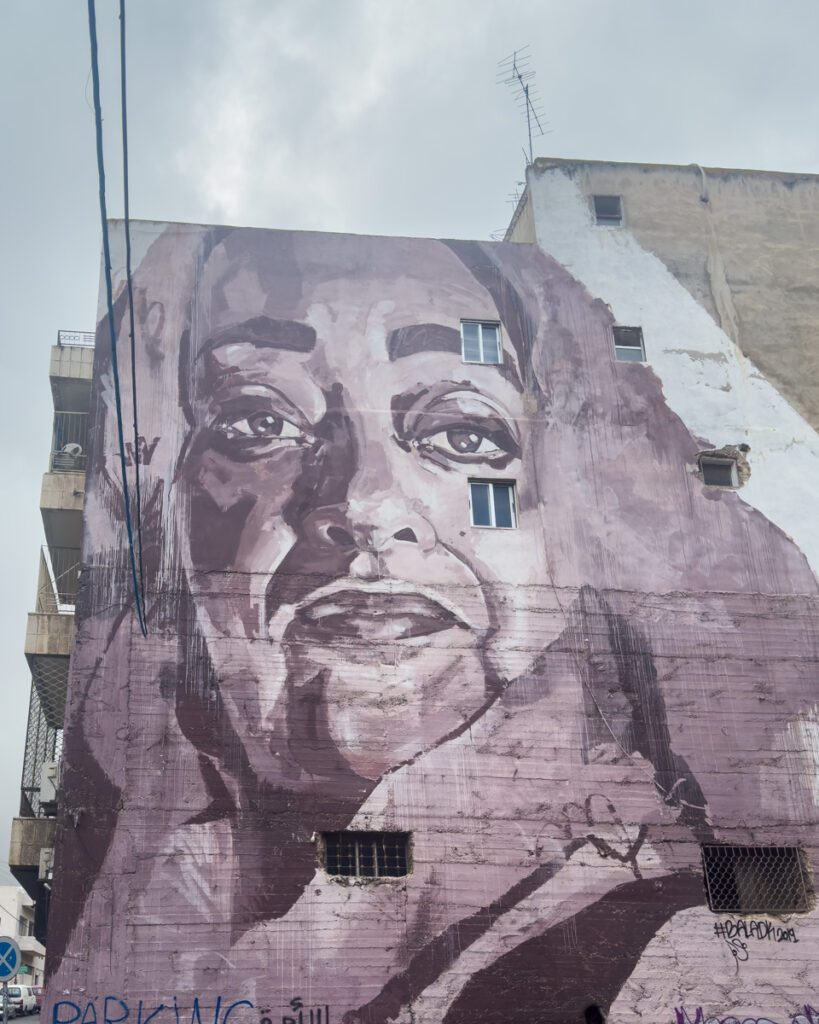

We had no idea street art played such an important part in the city’s landscape. We later found out that there was a street art festival that started in 2013 called the Baladk Street Art Festival. Each year, in April-May, the festival brings together artists to celebrate this art form.
If you’re interested in discovering some of the more unique pieces, you can check out this interactive map. It works great on desktop or laptop, but it’s not so mobile-friendly. So if you’re looking to find these pieces, we recommend checking them out on a big screen first and pinning the murals you want to see on your own Google Maps app.

Alternatively, you can also do a walking tour with Underground Amman. They do these tours in 2 different locations, Downtown Amman and Hashimi, which is a more residential, working-class area. The tours in Hashimi are on Saturdays at 10 am and the Downtown tours are on Sundays, Tuesdays and Thursdays at 4 pm, and Fridays at 10 am. Make sure you book through Underground Amman to save your spot.
Either way, while you’re walking around Amman, make sure you take the time to look around and admire the beautiful works of art that adorn the different buildings in the area.
5. Think about the Roman Empire at the Roman Amphitheater & Odeon
We’ll be honest with you, we didn’t really look much into the best things to do in Amman before getting here. Usually, we have a rough idea of what to do and then we talk to locals so they recommend their top activities and attractions. So, we didn’t know that Amman had so many remnants of the Roman Empire. And we didn’t know that smack in the middle of the city, you had this huge amphitheater!
Another one of the Amman attractions included in the Jordan Pass, the Roman Theater is a must-see!
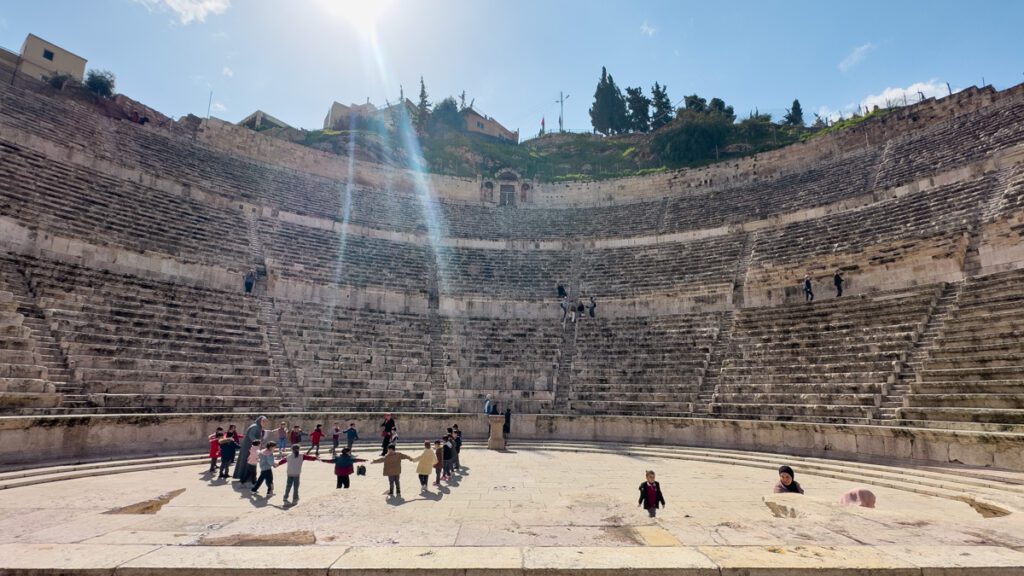
The date of construction of the Theater is still unknown. Some say it may have been built during the reign of Emperor Antoninus Pius from 138-161 CE, while other sources suggest it may have been constructed earlier, in the 2nd century CE.
The Amphitheater was part of the Roman city of Philadelphia and served as a venue for events like theatrical performances, gladiator contests and public assemblies. It could accommodate up to 6,000 spectators, making it one of the largest Roman theaters in the region. It’s really impressive to see!
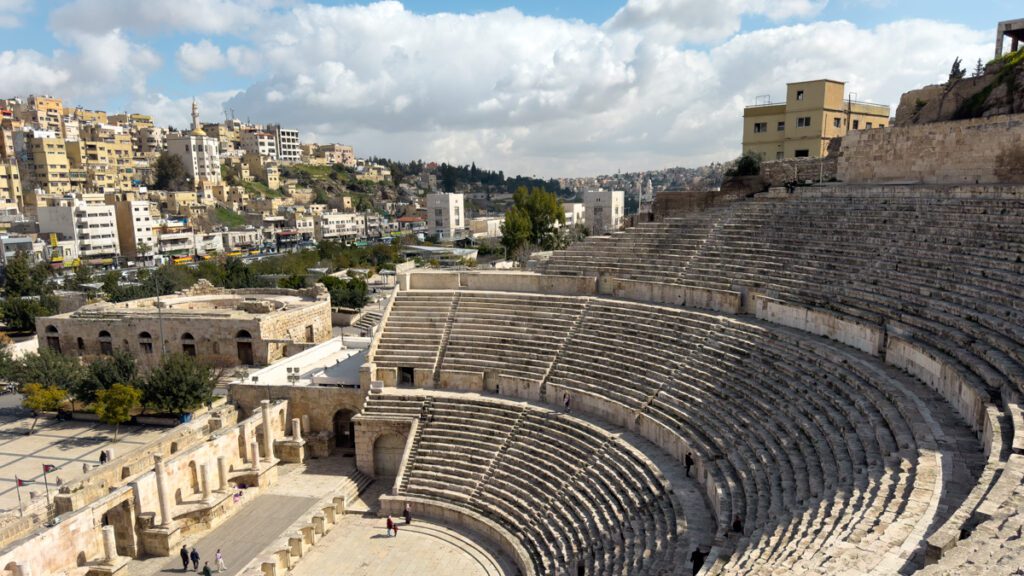
The Theater is still used today – you can see concerts, theatrical productions, and cultural festivals here. Since it was carved into the side of a hill, it has natural acoustics, as well as stunning views of downtown Amman and the surrounding area. Not a bad venue!
The Theater has its own Folklore Museum you can visit. It’s nothing big, but it shows you what life was like for the people of the region, as well as showcasing home furnishings and traditional clothes.
Next to the Theater, you’ll find the smaller Odeon, just on the side of Hashemite Plaza. It resembles the Amphitheater but on a much smaller scale. This is where the other concerts and cultural events took place. It’s also where they used to hold parliamentary sessions, according to the guard working there.
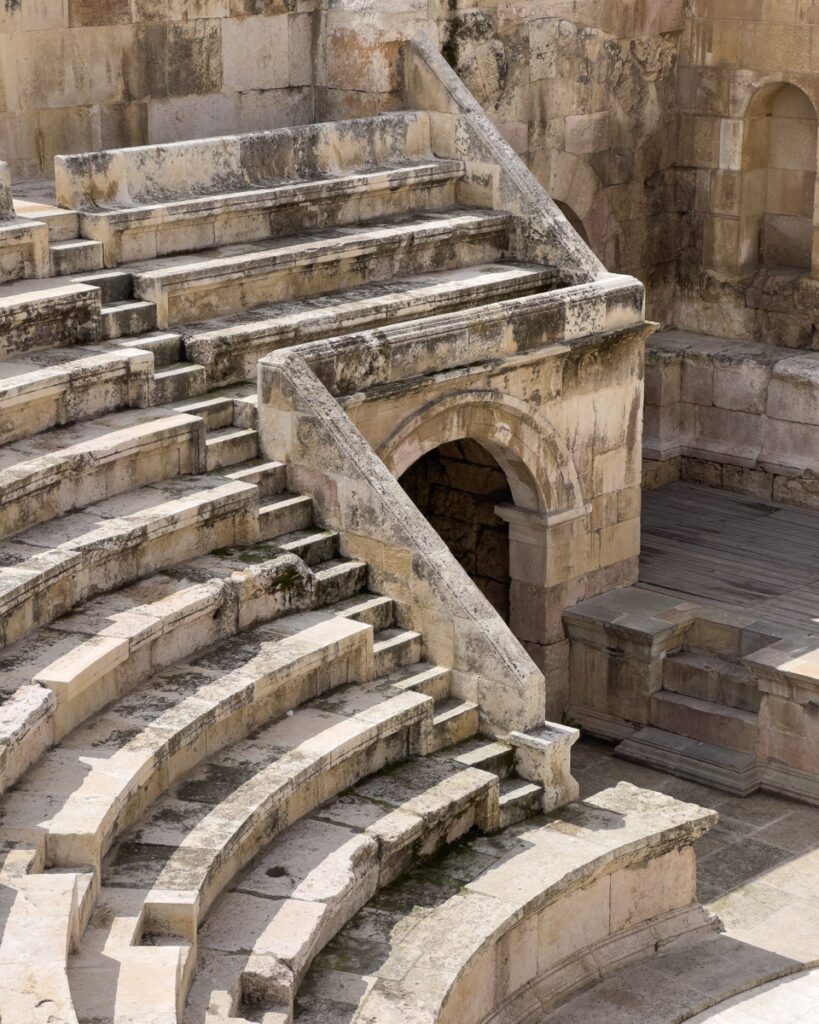
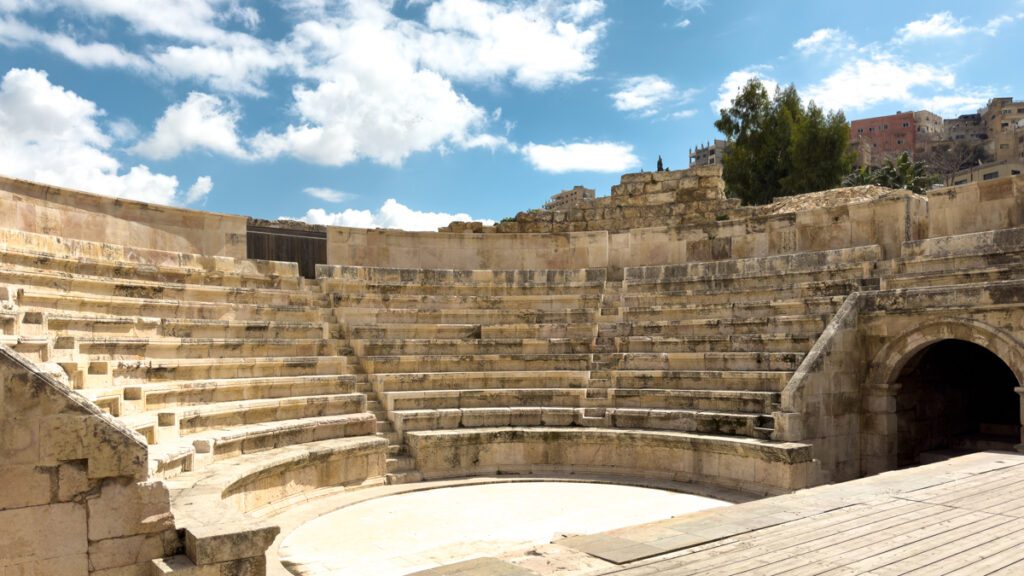
Make sure you wear sturdy shoes to climb up and down the Amphitheater steps (they’re not so even). And bring water and wear a hat. The sun is strong here and there is no shade! Also, make sure you climb up to the top of the Amphitheater – The views are really worth it!
You’ll need about 1-1.5 hours here, to visit the Roman Theater, Odeon and Folklore Museum.
ABOUT THE AMMAN AMPHITHEATER & ODEON
Location on Google Maps
Hours of operation: Open on Sunday to Thursday from 8 am to 8 pm, and on Friday and Saturday, from 8 am to 10 pm.
Entrance fee: 0.25 JOD for locals. 2 JOD for foreigners
Included in the Jordan Pass
How long to spend here: 1-1.5 hours
6. Stroll around the Nymphaeum, one of the landmarks in Amman
Free to visit, and located in the heart of Amman, you have the Nymphaeum. Right across from a lively Souk, this place is almost forgotten by tourists and locals alike.
The Amman Nymphaeum is believed to be the biggest building of its kind in the region. Much larger than its counterparts found in Petra, Umm Qays, Jerash and Pella. Like most Roman ruins in Amman, the Nymphaeum fell into despair after it was no longer in use. It was covered by sediment and debris and was only uncovered and restored in the 20th century.
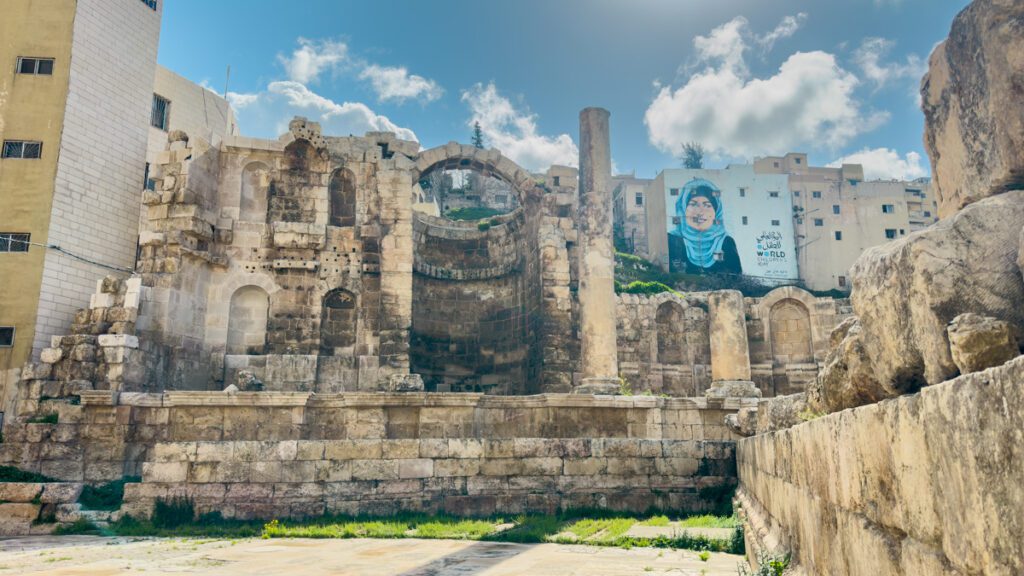
You’ll need about 30-45 minutes to explore the space and read about its rich history which dates back to the 2nd century CE, during the Roman era. However, it is believed that it was built atop an even older structure that dates back to Greek times. So it’s old!
The Nymphaeum in Amman was part of the ancient city of Philadelphia. It played a central role in providing water to residents and also served as a hub for social activities and religious ceremonies, as most nymphaeums typically do.
Walking around, you’ll notice many of the columns and structures are engraved with intricate carvings and reliefs. You’ll also see a series of arches and alcoves where they probably had more statues and elements decorating the space. You can even walk down to the central basin and the pool where water used to flow back in the day. Today, it’s mainly littered with trash from the street.
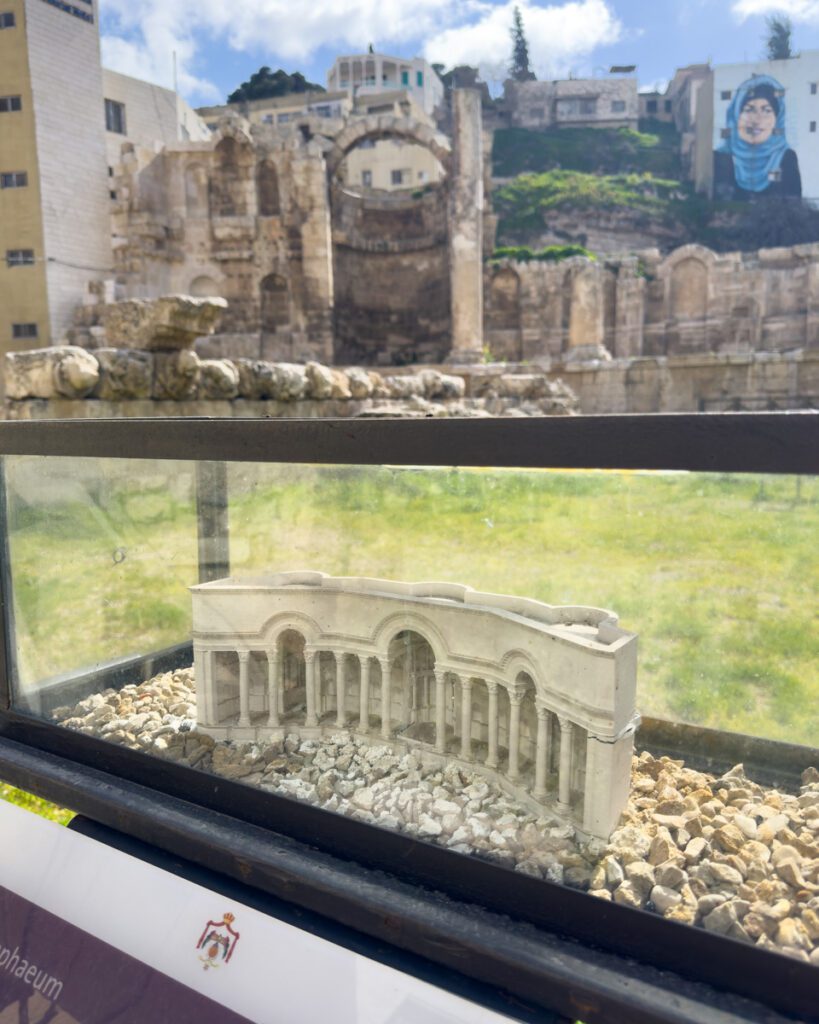
Although the space is free to visit, the man who stands guard at the entrance will ask for a tip when you leave. It’s up to you if you want to give him a JOD for pointing out certain things.
ABOUT THE AMMAN NYMPHAEUM
Location on Google Maps
Hours of operation: Open Saturday to Thursday, from 8 am to 3 pm. Closed on Fridays.
Entrance fee: Free
Not included in the Jordan Pass
How long to spend here: 30-45 minutes
7. Discover Duke’s Diwan, an architectural gem in Amman
In the heart of the city, amongst the bustling streets of the downtown area, there’s one of the oldest and best-preserved buildings in Amman. Walking through its turquoise door, and up the narrow stairs, you’ll discover Duke’s Diwan.
This place is free to visit, however, the lady who mans the door will somewhat pressure you into getting a tea or coffee. It will set you back 2.5 JOD, but it’s worth it for spending some time in this beautiful space. However, if you’ll only spend a few minutes looking around, you can kindly deny her.
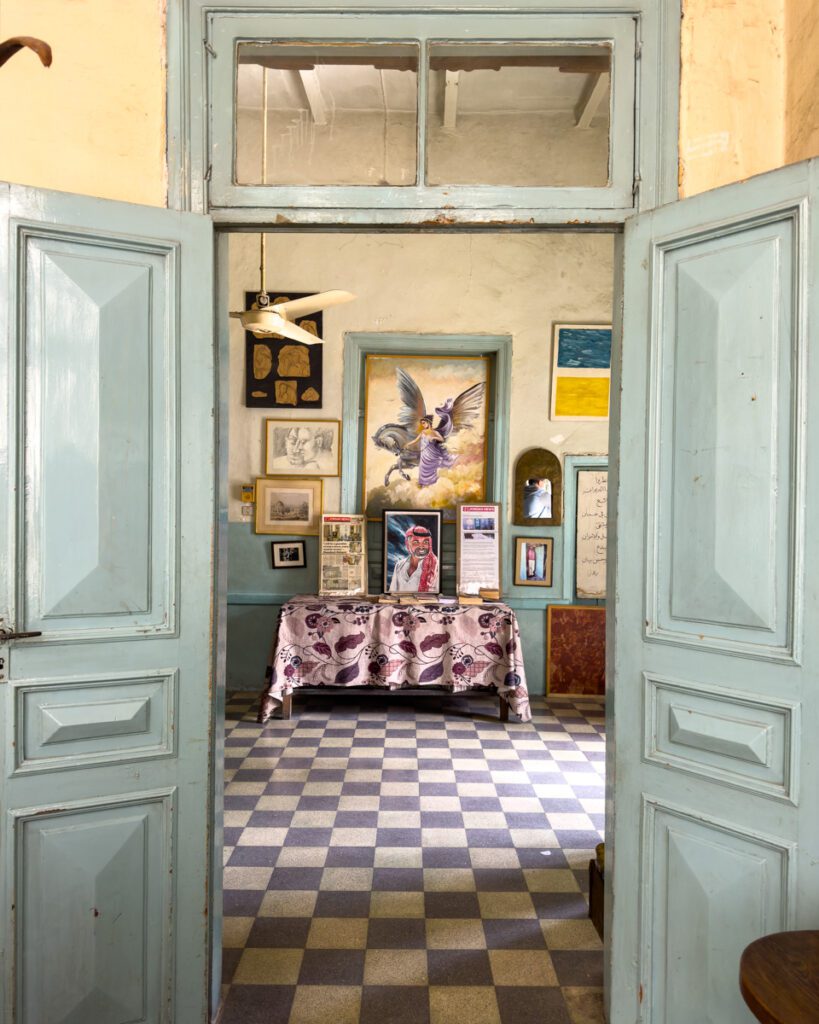
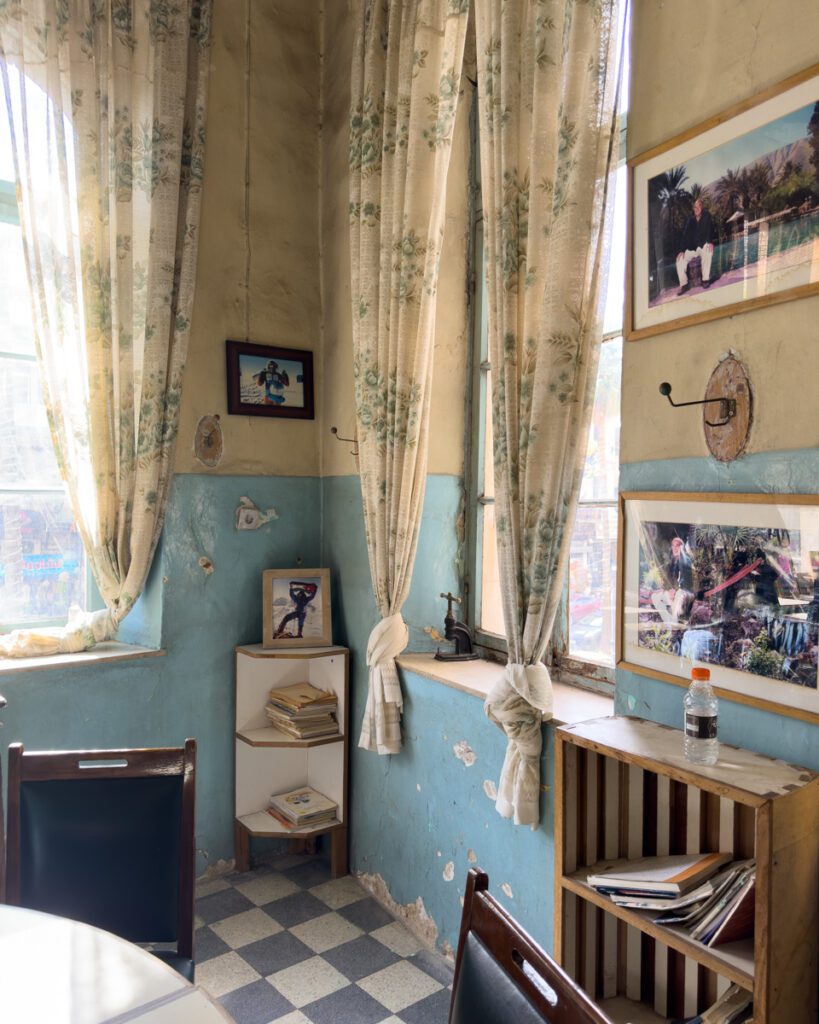
She won’t give you much information about the place apart from telling you it was a post office, then a hotel and now the Diwan. So if you’re curious about the place and its importance, here’s a quick overview of its history.
The place was built in 1924 by Abdul Rahman Madi, and it’s one of the last reminders of the architectural heritage of Old Amman. Initially, the building served as the Central Post Office for the Emirate Trans-Jordanian government until the late 1940s. After that, for 8 short years, it was home to an annex of the Ministry of Finance.
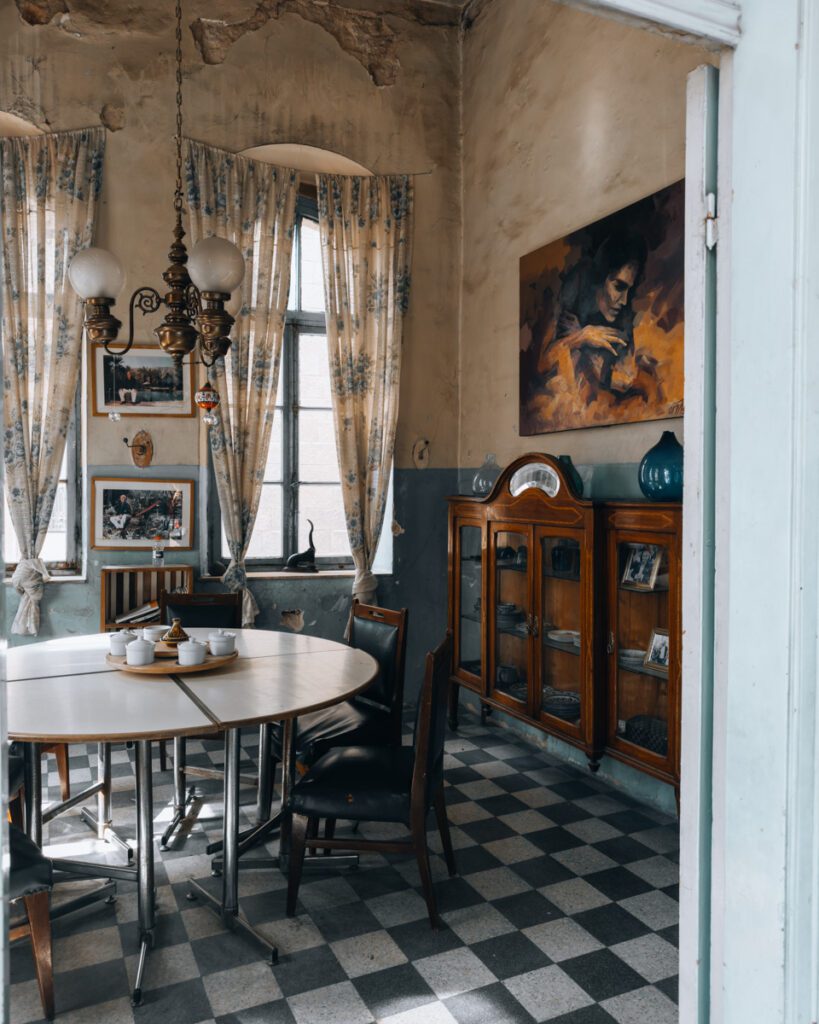
Starting in 1948, the five-room apartment was turned into the Haifa Hotel. It remained that way for 50 years. But in 2001, with the staggering growth and redevelopment in Amman, the space caught the attention of Mamdouh Bisharat who recognized the beauty and importance of this space.
Bisharat was known as the “Duke of Mukheiheh”. He was known for investing in the cultural heritage and preservation of space like this. Without his keen eye, and significant investment, Duke’s Diwan may have never been around today.
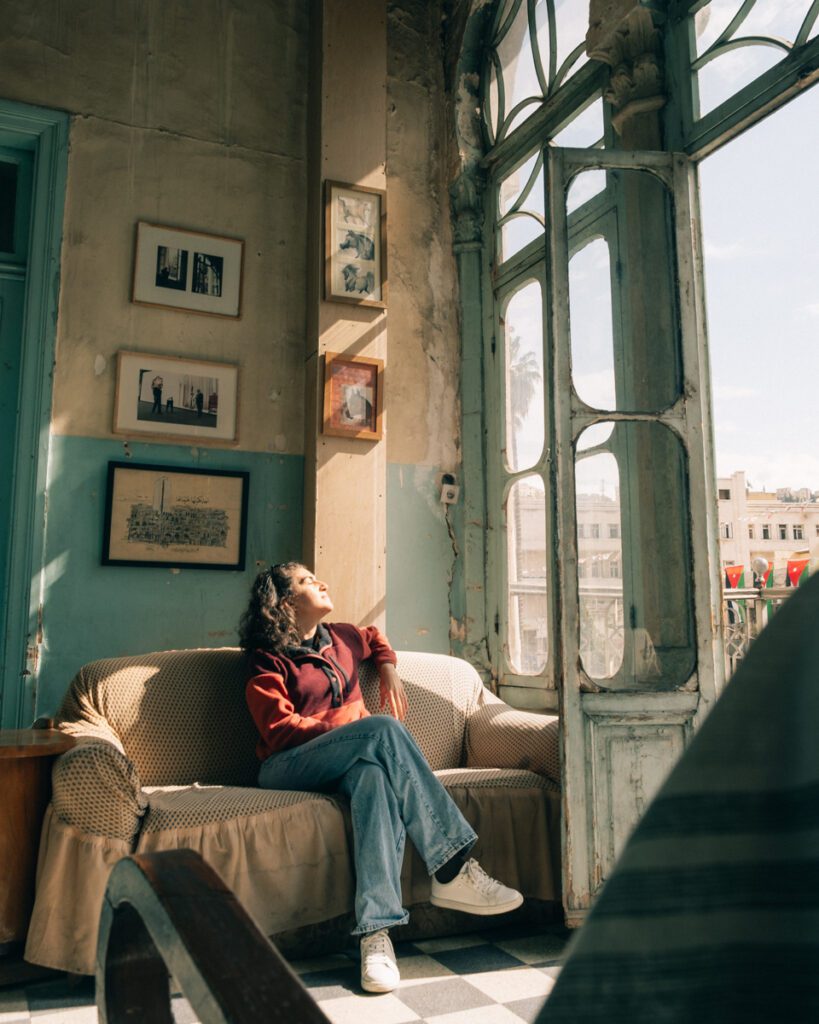
The name Duke’s Diwan comes from its benefactor’s moniker and “Diwan”, the Arabic word for the room of the house always open to guests, since its always been free to enlightened visitors. The modern Duke’s Diwan has become a meeting place for creators and visionaries from all over. They come here to celebrate the arts, have deep discussions and forums and contemplate the future of the arts and general affairs.
Today, walking around the rooms, you’ll see some old imagery, newspaper clippings and decorations that date back to the 1920s. You can stand on the balcony and get lost in the flow of people walking around.
It’s really fascinating to imagine what this place was like back in the days when worldly artists would meet here. Luckily, since most of the decor has been preserved, projecting yourself to those golden days will not be too hard!
ABOUT DUKE’S DIWAN
Location on Google Maps
Hours of operation: Open Saturday to Thursday, from 10 am to 5 pm. Closed on Fridays. They might also close early some days so show up before 4 pm to be safe.
Entrance fee: Free, but you may need to buy tea or coffee.
Not included in the Jordan Pass
How long to spend here: 30-45 minutes if you take a good look. 15-minutes if you only want to walk around.
8. Shop at the souks (markets) in the city
Of course, these are free to visit, but they’re not as fun if you don’t buy a few things – mainly food!
In the heart of the city, there are a few souks you can discover, our favorite (and most conveniently located, was the Souk al Sukar. It’s noisy, it’s busy and it’s awesome! This is where you can get a taste of the real Amman (and Jordan).
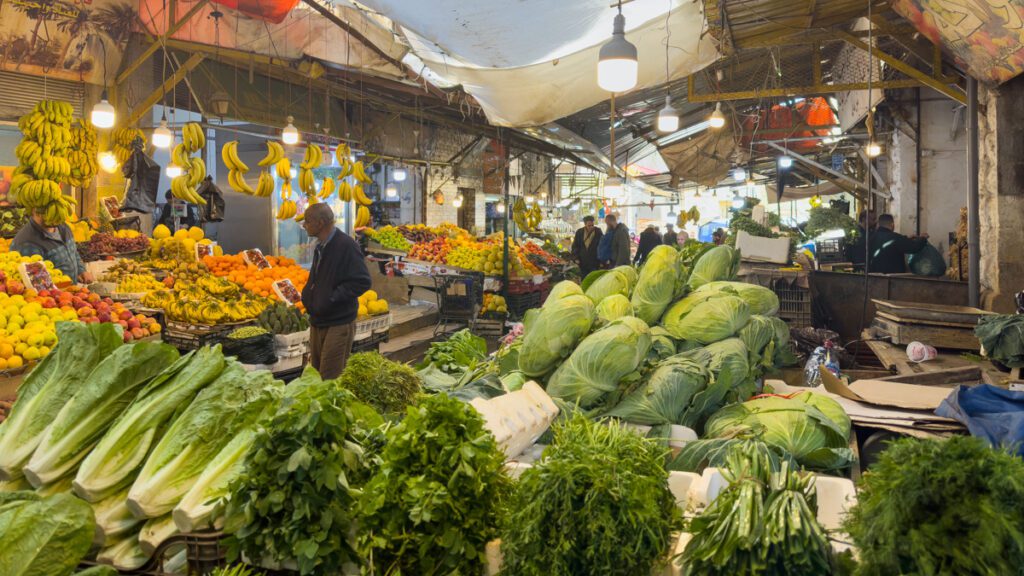
You’ll walk through alleys and alleys lined with stalls. Vendors calling out their specials in Arabic. Your eyes will feast on piles of fresh fruits and vegetables. And your nose will come alive with the fragrant smells from the herbs, spices and treats around you. If you want a bit (or a lot) of sensory overload, this is the place for you.
Since the Souk is so conveniently located, we would pop in every time we were in the area. Sometimes, vendors would offer us some sticky or tangy treat to try. Sometimes, we just wanted to take pictures. Each time we went, it was a different experience, and we loved it.
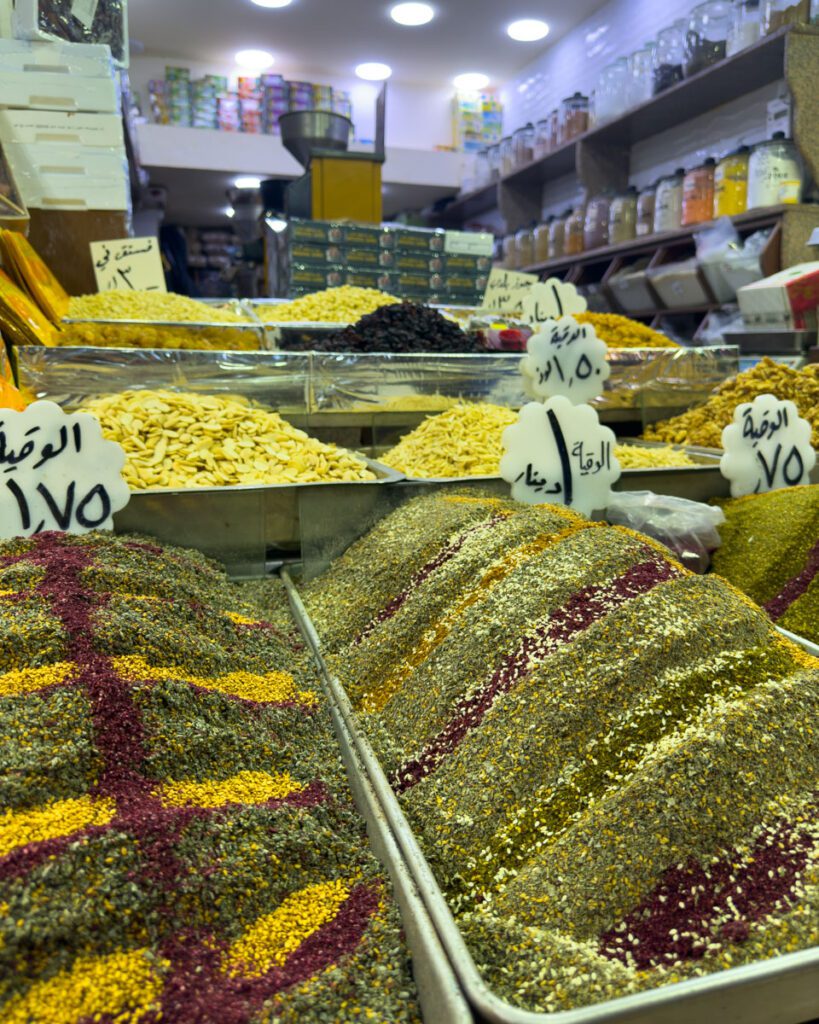

If you want to bring some edible souvenirs home, this is the place. You can find cheap and very fresh spices and herbs, teas, nuts and dried fruits. If you have a kitchen where you’re staying in Amman, you can also get your fresh produce here.
You can spend as much or as little time as you want here, and you can spend as much or as little as you want. But if you’re looking to get a good local experience, the Souk Al Sukar is a must-see in Amman.
ABOUT SOUk AL-SUKAR
Location on Google Maps
Hours of operation: Open daily. Stalls open at different hours, but it’s busiest mid-day, from 10-11 am to 2-3 pm. The vibe is very different at night.
Entrance fee: Free
Not included in the Jordan Pass
How long to spend here: 30 minutes
9. Enjoy the good life on Rainbow Street, one of the liveliest places in Amman
Rainbow Street has a big reputation in Amman. This small road is famous for its shops, bars and restaurants, its lively atmosphere and a bit of a party scene… well as big of a party as you can get in a Muslim country where drinking isn’t really a thing…
We have to admit that we didn’t get to experience everything this street is known for because we visited Amman during Ramadan. So it was a lot less lively than usual.
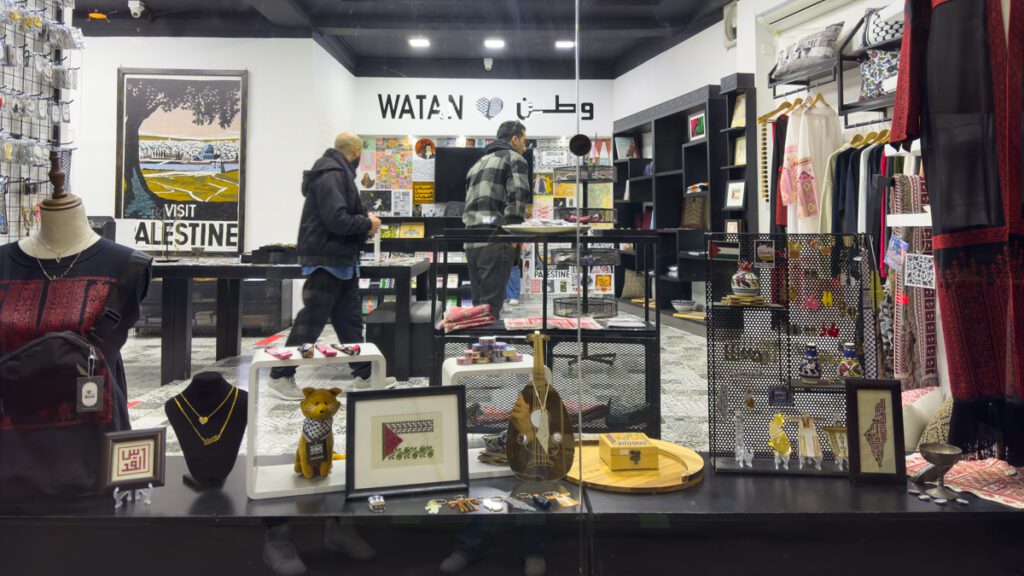
But if you’re looking to try different kinds of cuisines, or if you want to mingle with a younger crowd, we recommend walking around here. It’s also a great place to browse through unique shops and boutiques, including some cool and vintage antique shops and handmade artisan goods.
Speaking of shopping, this is the Souk Jara pop-up market which takes place just off one of the streets around Rainbow Street. See the location here. It happens on Fridays from 10 am to 10 pm in the summer. However, we’re reading conflicting information about it, as it may be closed. If you see it’s open when visiting Amman, let us know and we can update this part. From what we read, it’s better to come earlier as it get quite crowded after 5 pm.
If you have the time, pass by Rainbow Street on your way to some of the other attractions on this list.
ABOUT RAINBOW STREET
Location on Google Maps
Hours of operation: Depends on the business
Entrance fee: Free
Not included in the Jordan Pass
How long to spend here: 1-2 hours, depending on how much you want to shop
10. Discover the history of the country at the Jordan Museum, one of the most interesting attractions in Amman
If you’re like us, you may get unlucky with the weather in Amman. If so, you may want to spend some time indoors, learning more about Jordan. Enter the Jordan Museum.
Located downtown, this is a great place to gain some knowledge about the country you’re in. The Jordan Museum is known for its extensive collection and exhibitions that showcase the rich history, heritage, and cultural diversity of the Hashemite Kingdom of Jordan. Established in 2014, this museum will give you more insight into the country’s archaeological, historical, and cultural significance.
You can browse through collections that date back to the prehistoric times. Plus, you can see artifacts and objects from ancient civilizations like the Nabateans, Romans, and Byzantines, as well as on Jordan’s Bedouin culture, Islamic heritage, and modern history.
Some of the highlights you shouldn’t miss are the Dead Sea Scrolls – they’re among the most important archaeological discoveries of the 20th century. Plus, some artifacts from the ancient city of Petra, one of the highlights in Jordan.
If you have some time to spare, or if you get unlucky with the weather, the Jordan Museum is a great place to spend an hour or two while learning about the rich history of this country.
ABOUT THE JORDAN MUSEUM
Location on Google Maps
Hours of operation: Open Wednesday to Monday from 9 am to 4 pm. Fridays, open from 2 pm to 5:30 pm. Closed on Tuesdays.
Entrance fee: 1 JOD for locals. 5 JOD for foreigners
Not included in the Jordan Pass
How long to spend here: 1-2 hours
11. Take in the views of Amman from different vantage points around the city
Laid across seven hills, Amman is quite impressive to see. Luckily, there are many viewpoints around the city where you can take it all in.
Some viewpoints will highlight specific Jordan attractions like the Roman Theater, while others will give you a glimpse at the whole city. We’ve laid out the best viewpoints we found on the map at the top of this list.
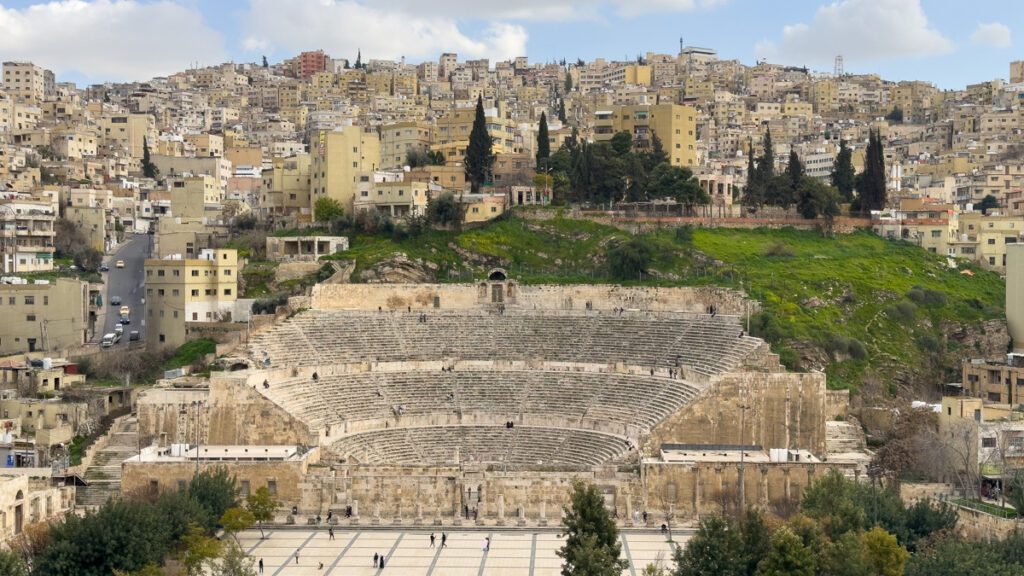
However, since Amman is built on hills, anytime you climb stairs, you can turn around and take the view in! This is what we recommend. And if you happen to be close to one of the intentional viewpoints, then you can stop to take in the sights there.
If you want to have a meal or drink while admiring the view of the city, we highly recommend you head to Wild Jordan Center. Not only are the views from here breathtaking, but the food is delicious. Plus, they have quite a few vegan options to choose from.
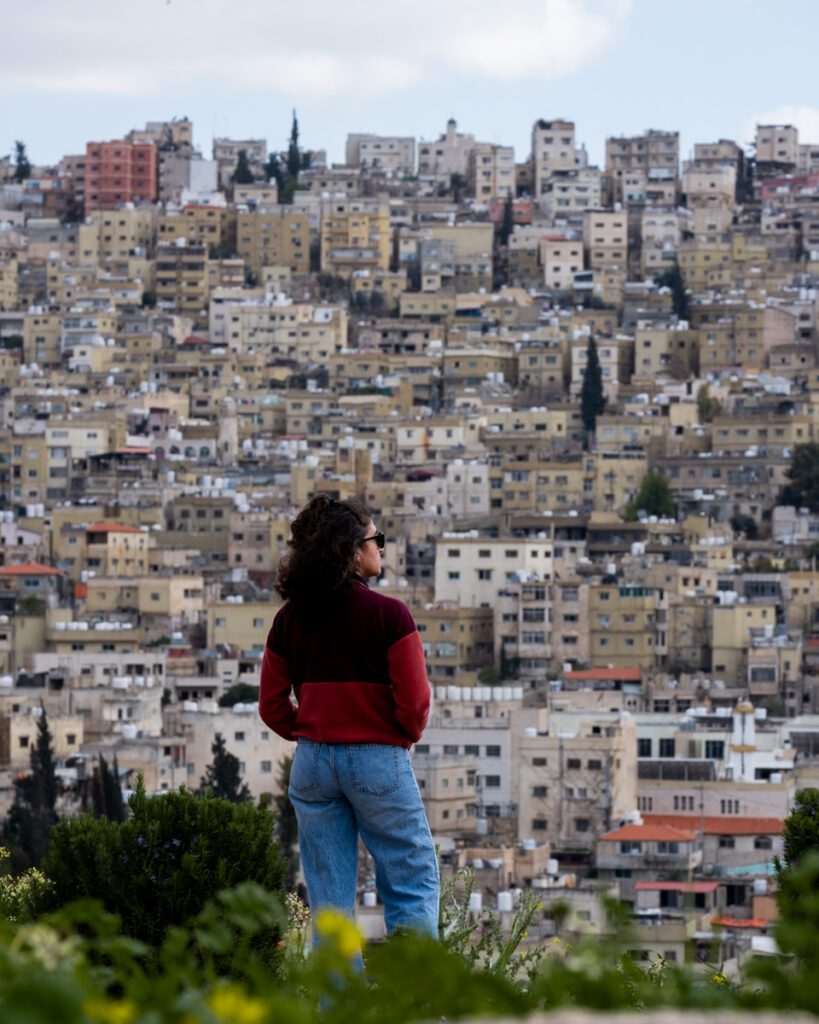
What makes this place even more special is that it’s owned and operated by the Royal Society for the Conservation of Nature. The center helps produce an income for the rural communities through its 8 reserves in Jordan. The Nature Shop generates income for the families of the reserves and the Center promotes ecotourism.
12. Go for a day trip from Amman
Amman is a great place to base yourself if you want to go on day trips. There are quite a few of them that are easily accessible from the capital. If you don’t have a rental car, and you still want to see some of the highlights of Jordan, here are some of the best day trips you can go on from Amman.
You can choose to do these on a private tour or a guided group tour. See what best works with your schedule and budget. For all tours we’ve included, we’ve already checked that the ratings were the best ones for their offering, so you can go with the peace of mind of choosing a top-rated tour provider. However, we still recommend you take a look to make sure you know what you’re getting.
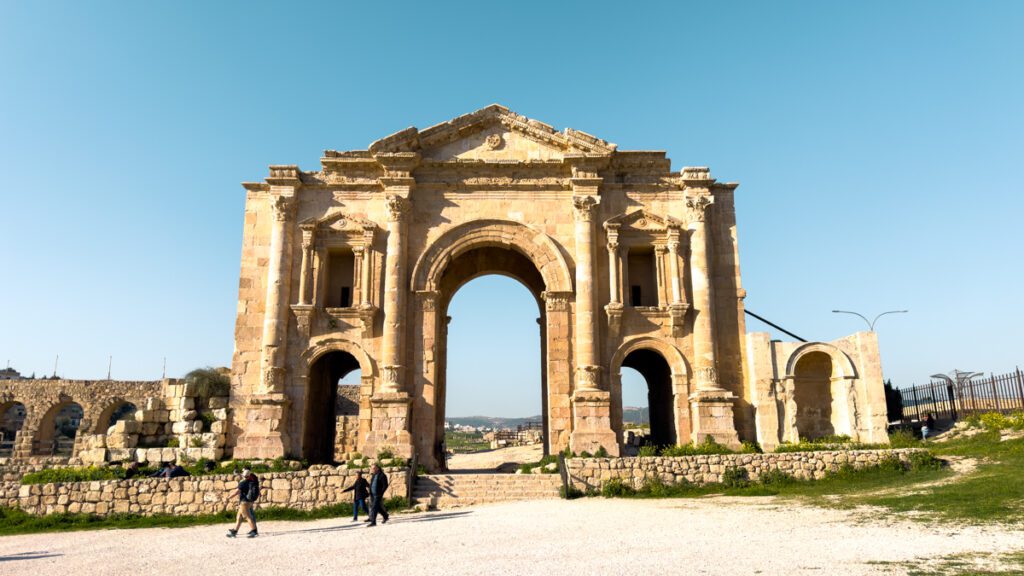
- Jerash. About 45 minutes away from Amman. You’ll visit the ancient city of Jerash, one of the best-preserved Roman provincial towns in the world. The site is quite large. We spent 2.5 hours here and barely scratched the surface. Jerash is included in the Jordan Pass.
- Ajloun Castle and Umm Qais. About 1.5-2 hours by car. Just north of Jerash. The Ajloun Castle is a 12th-century fortress built to defend the city against the Crusaders. And the ancient Roman city of Umm Qais (Gadara) is known for its well-preserved ruins and panoramic views of the Sea of Galilee and the Golan Heights. From Umm Qays, you can see Palestine, Jordan, Syria and Lebanon (on a clear day). It’s a beautiful place to explore. Both the Ajloun Castle and Umm Qays are included in the Jordan Pass.
- Dead Sea. About 1 hour by car. Day tours will take you to float on the super salty shores of the Dead Sea. It’s also the lowest point on Earth. You can hire a taxi to drop you off at one of the resorts where you can enjoy the waters, therapeutic mud and all the amenities they offer.
- Madaba and Mount Nebo. About 30-40 minutes away from Amman. The town of Madaba ended up being one of our favorite places to explore in Jordan. It’s known for its Byzantine and Umayyad mosaics, including the famous Madaba Map depicting the Holy Land at St. George’s Church. Hopefully, the tour will allow you to capture the view of this cute town. You can also continue to Mount Nebo, where Moses is said to have seen the Promised Land. Mount Nebo is not included in the Jordan Pass.
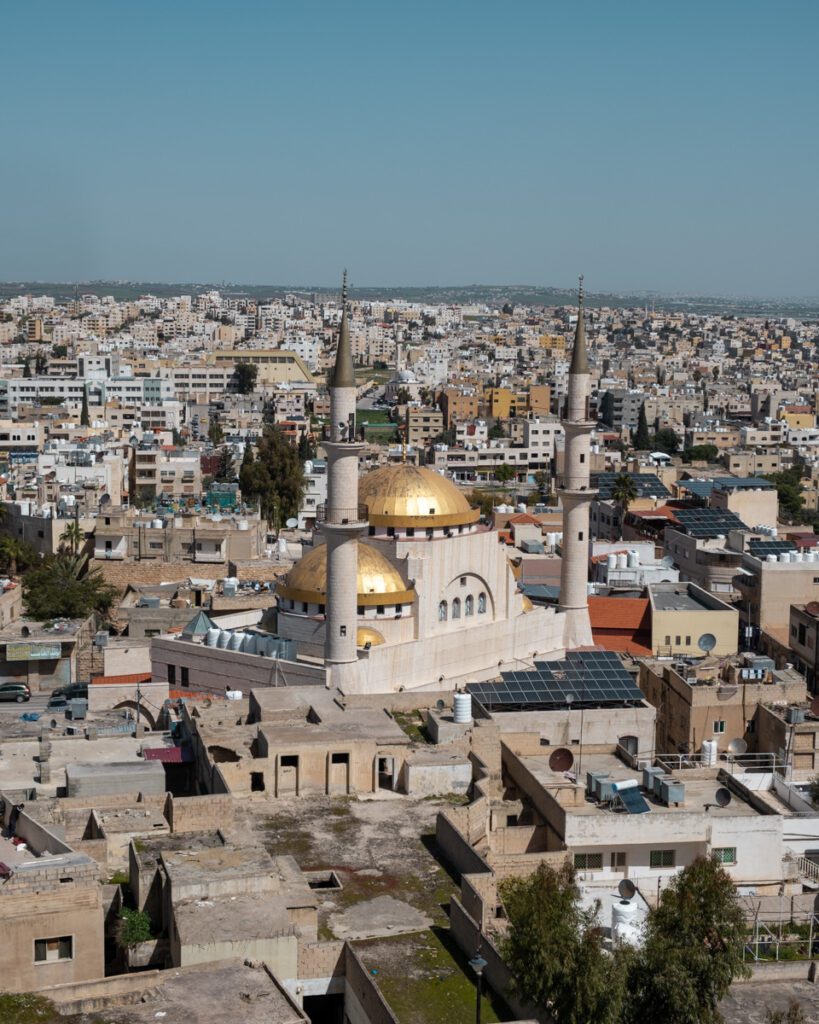
- The Desert Castles. 1-2 hours east of Amman, depending on how far you go. There are 3 castles to visit & the reservoirs. They are included in the Jordan Pass. Day trips are available from Amman.
- Qasr Amra – One of the most famous Desert Castles, a UNESCO World Heritage Site known for its well-preserved frescoes and intricate mosaics
- Qasr Kharana – An imposing fortress. One of the best-preserved examples of early Islamic architecture in Jordan.
- Qasr al-Azraq – Dates back to Roman times but was later renovated and expanded by the Umayyads. Became famous during the Arab Revolt of 1917 when it served as the headquarters of Lawrence of Arabia.
- Hallabat and Amra Reservoirs – They provided crucial water sources for the inhabitants of the Desert Castles. They are architectural marvels, offering insights into ancient water management techniques.
Now, a big question about taking a day trip to the most famous places in Jordan – Petra and Wadi Rum.
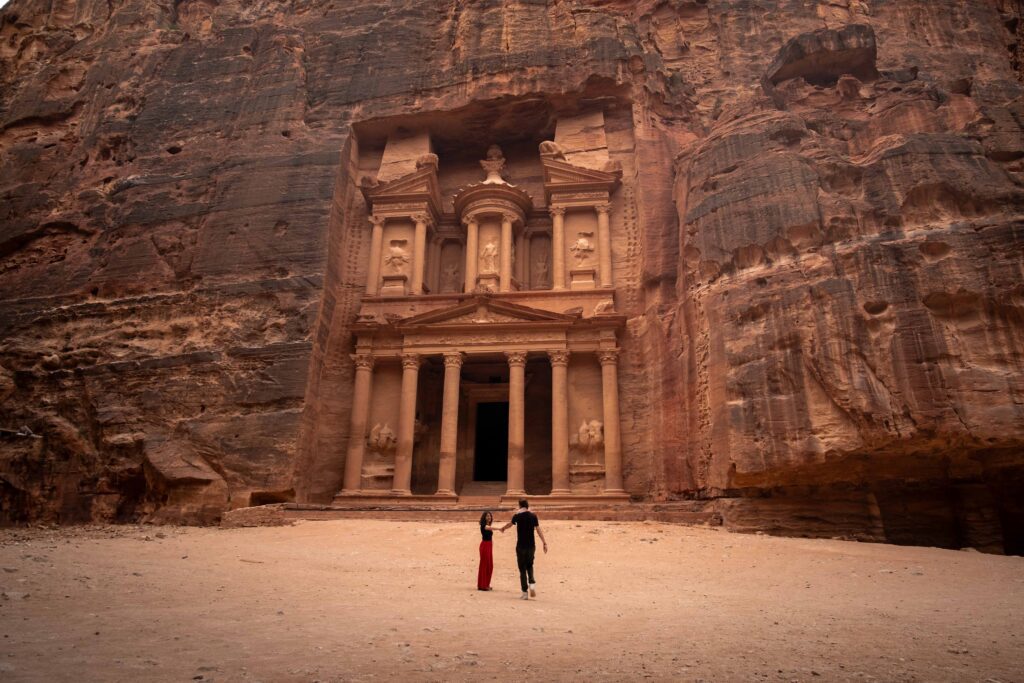
Should you take a day trip from Amman to Petra?
Short answer. No.
Long answer. Still no! But if you have 3 days in Jordan, maybe…
So, this may be a subject of debate, but to us, you definitely need more than half a day to fully immerse yourself in the immensity and magical vibes of Petra. There’s a reason this place is not only a UNESCO Heritage site, but also, one of the 7 Modern Wonders of the World.
The drive from Amman to Petra is 3 hours long. Round trip, you’re spending 6 hours of your day driving. Which leaves very limited time on the actual site. Even if you get there early and leave late, you’ll barely scratch the surface. You might get to see some of the highlights, and that’s about it.
We suggest having at least 1 full day in Petra and if you have the time, we actually recommend you do 2 days there. It’s the best way to truly get a feel for the place, see more than just the highlights and understand how significant this place really is.
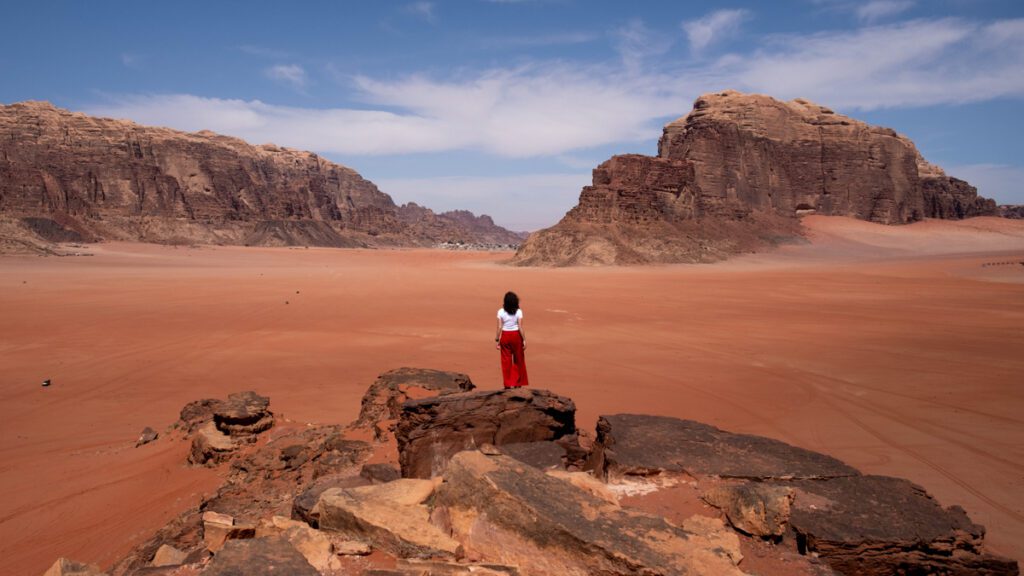
Should you do a day trip to Wadi Rum from Amman?
You can probably guess the answer here, but no, you should not do a day trip from Amman to Wadi Rum. You need at least 1 night there (if not 2) to get a feel for it.
Sure, again, if you have very limited time here, you can go on a Jeep tour to see the highlights then go on your merry way, but that’s not what makes Wadi Rum so special.
Unless you have a real attachment to the Nabateans or to Lawrence of Arabia, most of the sites you’ll see on your Jeep tour are not that extraordinary. You can read all about our experience in Wadi Rum here.
What makes spending a night (or two) so memorable in Wadi Rum is the sense of peace and quiet you get from being surrounded by a vast nothingness. Plus, one of the highlights of being in Jordan is to watch at least 1 sunset in the desert, and more importantly, to see the stars shine bright!
So don’t skip out on having at least 1 night in the deserts of Wadi Rum. You’ll surely regret rushing through this experience if you only go on a day trip.
If you are strapped for time, here are some highly-rated day trips to Wadi Rum & Petra
4 extra things to do in Amman
We had 2 full days in Amman, and there are a few things we didn’t have a chance to do, but we heard great things about them. So if there’s something here that piques your interest, take a look and see if you can make the trek there.
- Join a cooking class to learn traditional Jordanian (Middle Eastern) cuisine. The best souvenir you can bring back to friends and family back home is to wow them with amazing food!
- Go shopping at Abdali Mall. This is an upscale modern chic place located away from Downtown – many locals recommend we check it out. But we’re not shoppers! This is where you’ll find newer fancy hotels like the W Amman, and many restaurants and bars. If you want to mingle with trendy locals, this is where they hang out. It’s the perfect spot for lunch or dinner.
- Visit the Automobile Museum. This is where you can see the Royal Family’s collection of cars. It’s actually the first public automotive museum in the Arab region. It opened its doors in 2003 and serves as a tribute to the late King Hussein. It’s also a walk down memory lane of parts of Jordan’s history. At the museum, you can see a total of 80 cars and motorcycles. Some date back to 1909. Note that the museum is open daily, but closed on Tuesdays. Of course, this is the day we had available to see it! Check out their official site here.
- Check out these art galleries:
- Jordan National Gallery of Fine Arts. This is where you can discover contemporary Middle Eastern artists on permanent display. There’s also the Jungle Fever Cafe on the third floor where you can grab a bite or sit for a drink. The Gallery entry fee is 2 JOD per person. Official site.
- Dar Al-Anda Art Gallery. Open by appointment only. This is a female-owned gallery that displays a curated collection of modern Middle Eastern art and sculpture. Open 11 am to 7 pm, closed Thursdays + Fridays. Official site.
- Wadi Finan Art Gallery. Established in 2008, this gallery is a hub for Jordanian visual arts that showcases the work of Arab artists with contemporary and modern aesthetics. This is also where you can discover the work of Zaid Shawwa. Official site.
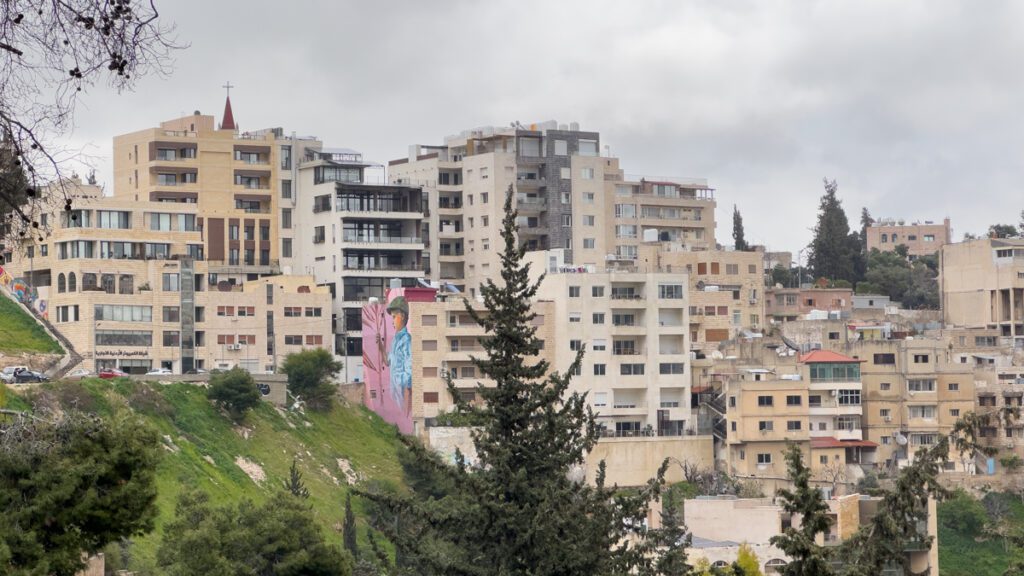
How to spend 1 day in Amman
If you only have one full day in Amman on your Jordan itinerary, here’s how we recommend you spend your time. As always, use this as a loose guideline to tailor your day to the interests you have.
- Start with the Roman Theater & the Odeon. Spend about 1-1.5 hours here.
- Head back toward the Nymphaeum. Stop in for a quick look, about 30 minutes.
- Stop in at The Duke’s Diwan and hang out.
- When you’re done, head to Hashem for their famous falafel & hummus. Keep some room for dessert at Habiba. Their signature treat is the kunafa.
- Walk through the Souk Al Sukar. You can grab a few things to bring with you as snacks to enjoy at your next stop.
- Walk or take a cab to the Amman Citadel. If the sun is strong, we recommend you start with the museum.
- If you have the time and the energy, you can head to check the Abdullah I Mosque
- If not, head back to your hotel and hang out.
- For supper, we recommend Bayt Sara, whether you’re vegan or not. The portions are huge, the atmosphere is cozy and the food is amazing.
- Another great option is the Wild Jordan Center, if you’d like to enjoy the view of Amman at night.
And that’s how we would recommend spending a full day in Amman.
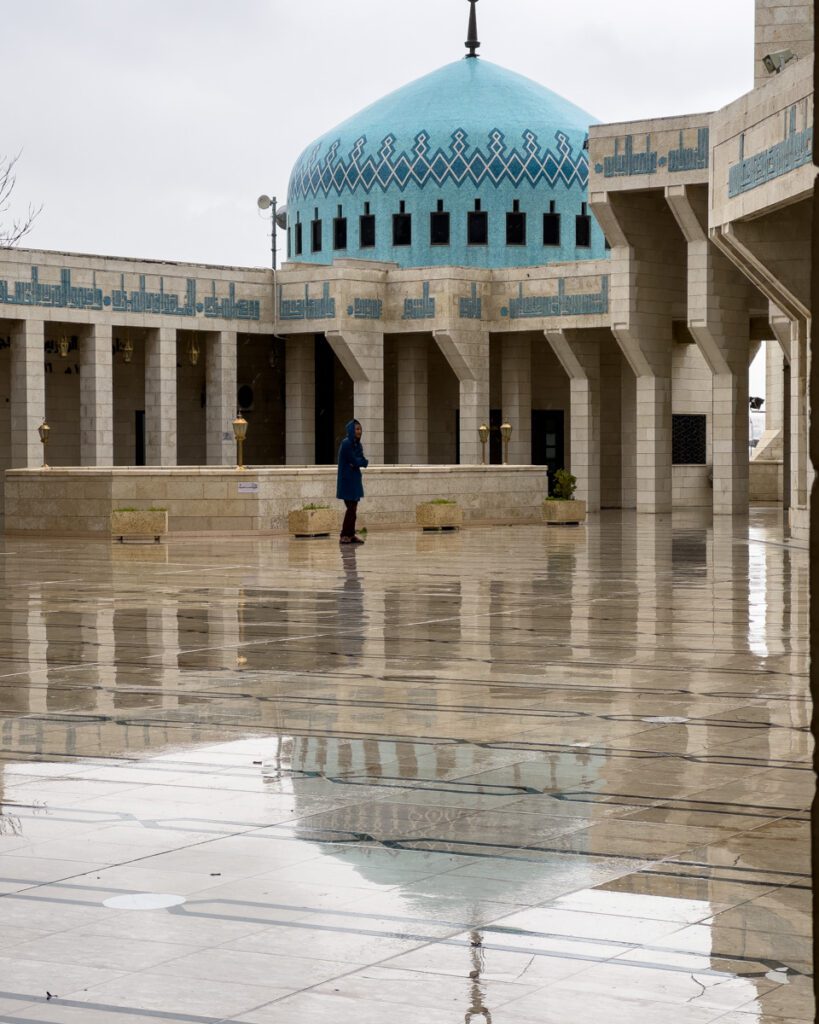
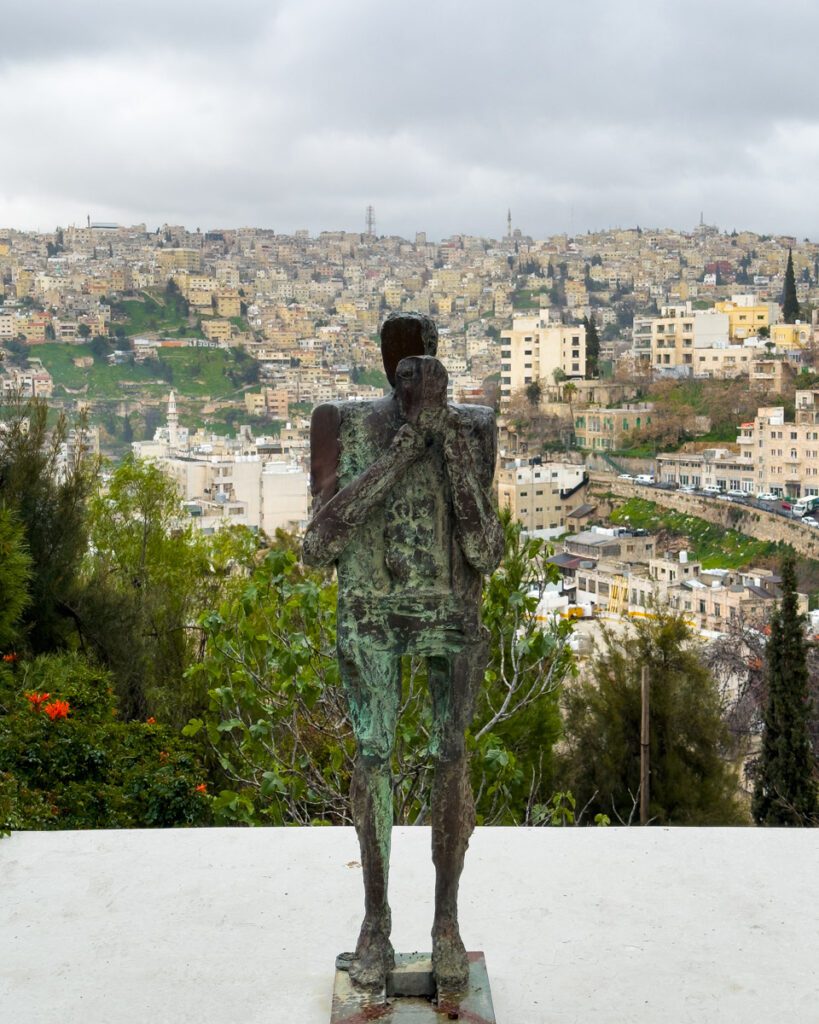
How to spend 2 days in Amman
If you have the time, we actually recommend spending 2 full days in Amman. This will allow you to visit at a slower, more leisurely pace, and you can see all the best attractions, and then some.
Here’s how we would spend 2 days in Amman:
Day 1
- Start with the Roman Theater & the Odeon. Spend about 1-1.5 hours here.
- Head back toward the Nymphaeum. Stop in for a quick look, about 30 minutes.
- Stop in at The Duke’s Diwan and hang out.
- When you’re done, head to Hashem for their famous falafel & hummus.
- After you’ve eaten your fair share, head to Darat al Funnan to take in the arts.
- On your way back, stop at the souk and take in the sounds, smells and sights. And don’t forget some tasty souvenirs too!
- At night, head to Bayt Sara for a delicious meal.
Day 2
- Walk or take a cab to the Amman Citadel. Start by exploring the outdoor parts first and when the sun gets strong, head to the museum.
- For lunch, head to Wild Jordan Center. Here, you can enjoy a stunning view and delicious food.
- Head the King Abdullah Mosque. We recommend walking as it’s the best way to take in the street art, but if it’s too hot in the afternoon sun, you can take a cab.
- In the afternoon, we recommend walking around the town. Fun boutiques and little coffee shops are waiting to be discovered.
- Slowly head to Rainbow Street for an evening of delicious food and fun vibes.
This is how we would spend our 2 days in Amman!
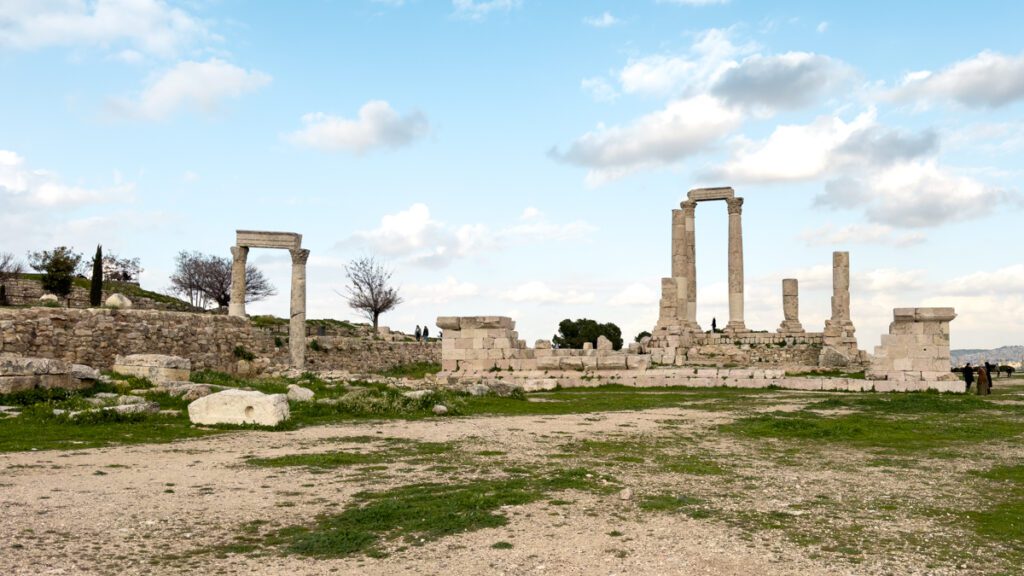
How to get to Amman
There are a few ways to get to Amman, whether you want to fly in or drive through the borders of neighboring countries. Here is some quick information about your different options.
Flying into Jordan for international travelers
This is probably the easiest and best way to get to Amman.
Jordan has 2 different airports you can fly into:
- Queen Alia International Airport (AMM). Located in Amman, about 45 minutes from the city center. The Queen Alia Airport is the main international airport in Jordan. Most visitors will come in through here as there are frequent flights from Europe and the Middle East.
- King Hussein International Airport (AQJ). This airport is located in Aqaba. Some international flights used to come in through this airport, mainly from Europe. However, since the war in Gaza, all flights to this airport have been redirected to AMM.
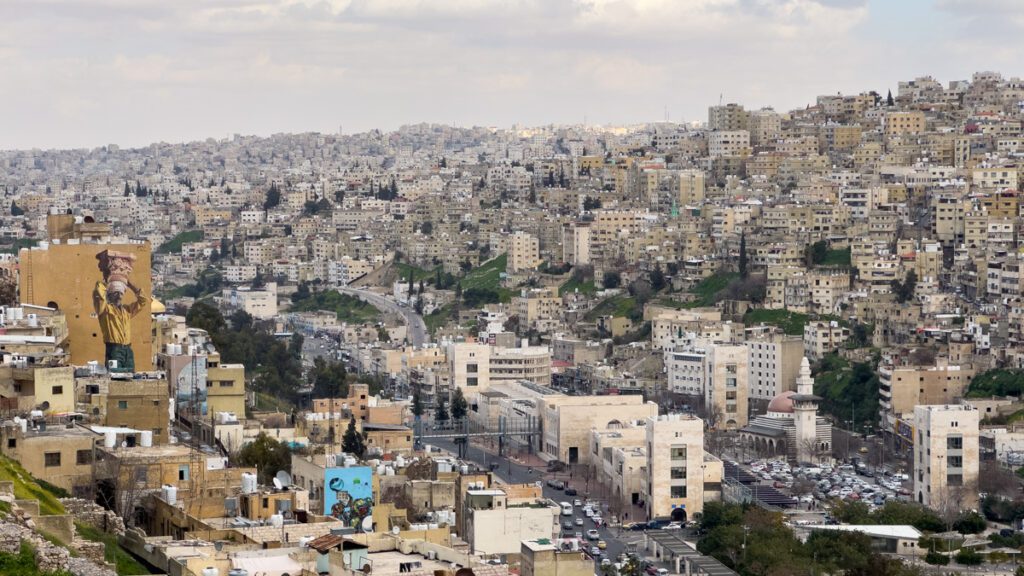
Getting into Amman by land
Finally, you can also cross the land border into Jordan to get to Amman from neighboring countries.
Crossing the land border from Isreal to Jordan
You can cross from Isreal into Jordan from three different border crossings. In talking to locals, it seems like Israel and Palestine are the countries most people visit when touring the Middle East. We’ll focus here on the crossings closest to Amman.
- King Hussein Bridge (Allenby) Terminal. Closest to Amman, As-Salt and Madaba. Open on Sundays, Tuesdays and Thursdays from 8 am to 11:45 pm. Mondays and Wednesdays from 8 am to 5:30 pm & Fridays and Saturdays from 8 am to 3:30 pm.
- Just note that this may be the longest border crossing from what we’ve read online. You must get your visa for Jordan or your Jordan Pass beforehand. You can’t get your visa at this border crossing. Plus, if you take a private car or tour bus, you must change vehicles upon crossing or use the other two border crossings.
- Jordan River/Sheikh Hussein Crossing. Close to Amman. Open from Sunday to Thursday, from 6:30 am to 9:00 pm, on Friday and Saturday from 8:00 am to 7:00 pm. The terminal is closed on Yom Kippur and the Muslim New Year (Id El Hijara). Most nationalities can get their visa at the border here, however, to avoid issues, we recommend getting it beforehand, if you can.
Note that if you are leaving from Jordan to enter Israel, you will have to pay an exit fee which varies depending on which crossing you choose. The fee is of either 8 or 10 JOD. There is also an exit fee for leaving Israel. You may also have to pay for a visa to enter Israel.
Crossing the land border from Saudi Arabia to Jordan
There are 3 different land borders you can cross to get in from Saudi Arabia. They’re all open 24/7, throughout the year. The closest one to Amman is the Umari Border Crossing which is 155km away.
Crossing the land border from Syria
If you’re coming to Jordan by road from Syria, you can cross into Jaber, which is the closest to Amman. It’s open from Saturday to Friday, from 8 am to 6 pm. Closed on Sundays.
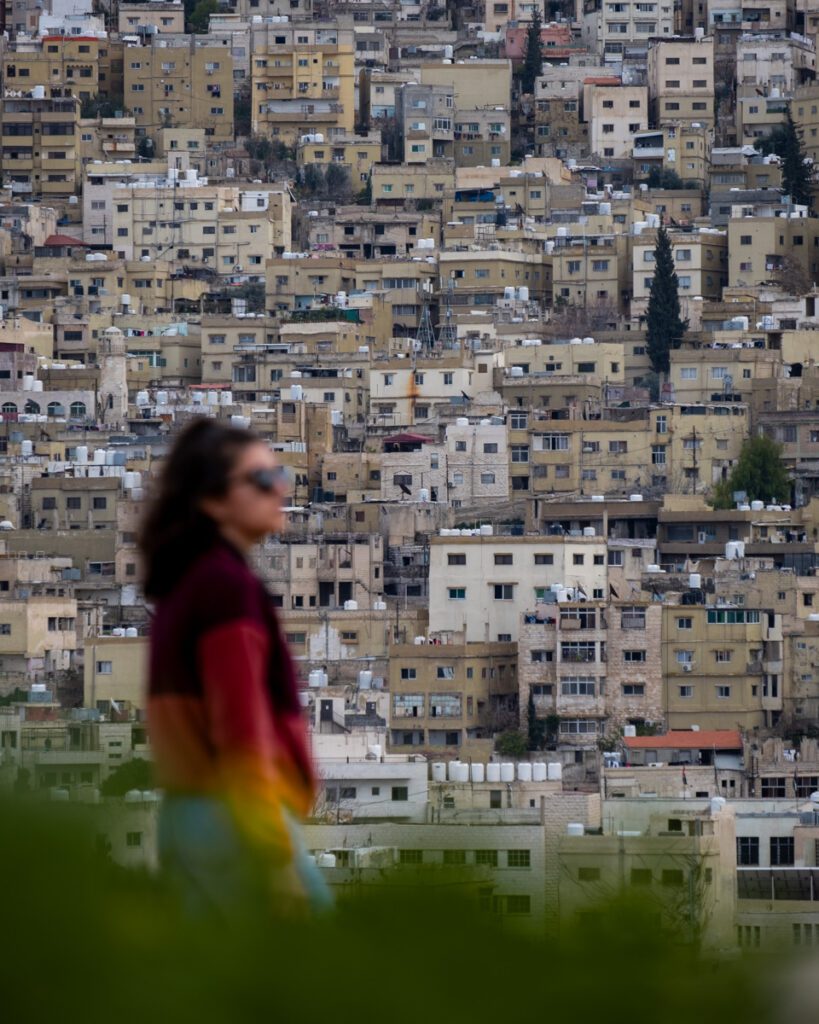
How to get around Amman
Amman is a fairly large city but the main attractions are in the city center where most travelers choose to stay. This makes getting around quite easy, as the city is quite hilly – get ready because you’ll be walking up and down stairways and hills all day long! Yes, we were sore after our time in Amman.
Renting a car in Amman
This is how we chose to explore Jordan for 18 days and we highly recommend this option to discover the beauty of the country. We rented our car with Rushmore and absolutely loved the service and the options of cars available. However, you don’t need a car to explore Amman.
The city is densely populated. Traffic can be a nightmare. And the driving gets some getting used to.
What we recommend instead is exploring Amman by foot (or cab) and getting your rental car only when you’re leaving the city. You can read more about driving in Jordan here. We get into the details about driving in Amman too.
With Rushmore, they dropped the car off at our hotel in Amman and we gave it back to them at the airport, on our way out. So convenient! They also checked in halfway through our trip to make sure all was good. Honestly, it was great service from start to end!
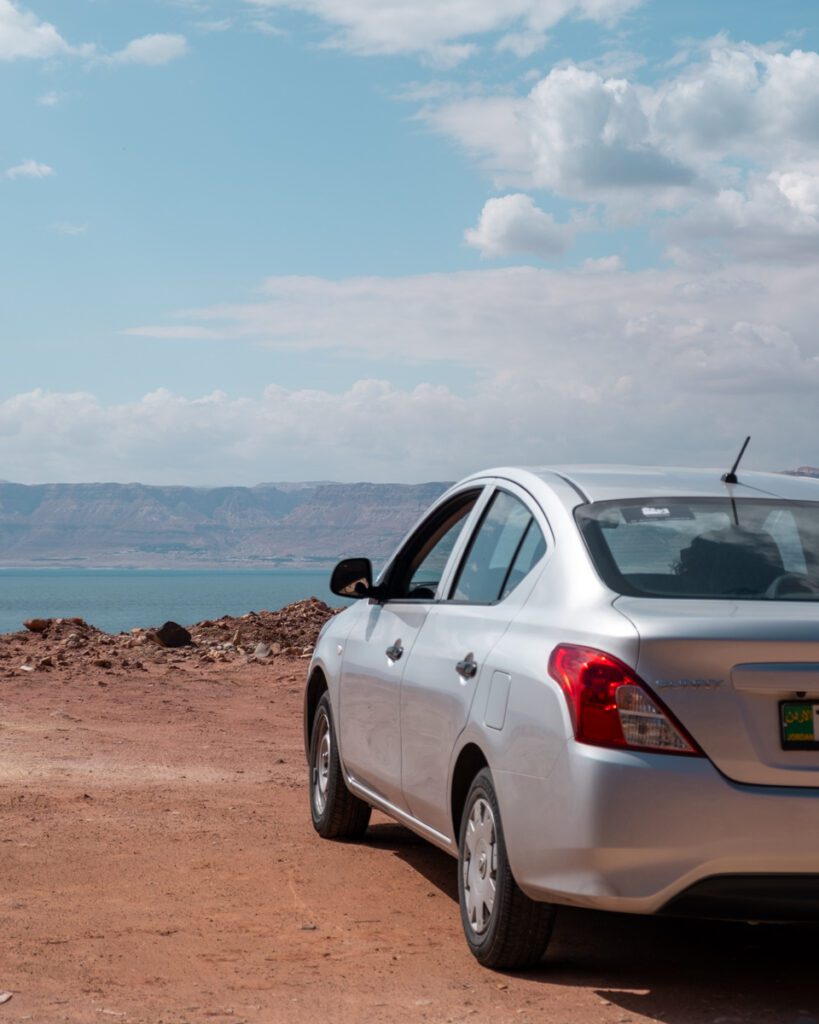
Walking around in Amman
This was our main way of getting around the city. Amman has been built on 7 hills, just like its Italian counterpart – Rome, with most of the attractions concentrated around the City Center. This is exactly how Rome has all its best attractions in the middle of the city too.
And just like in Rome, we walked up a storm here too! Make sure you wear comfortable shoes as this is the best way to explore Amman. You’ll get in quite a workout going up and down the stairways and hills in the city.
If you get tired, you’re in luck as there are cafés and restaurants all over where you can stop, grab a bite to eat and sip on coffee. If you want to make some friends and do a mix of walking and driving around, this tour his highly-rated and takes you around the best sites in the city.
And if you’re not too keen on walking around, then you can always take a cab.
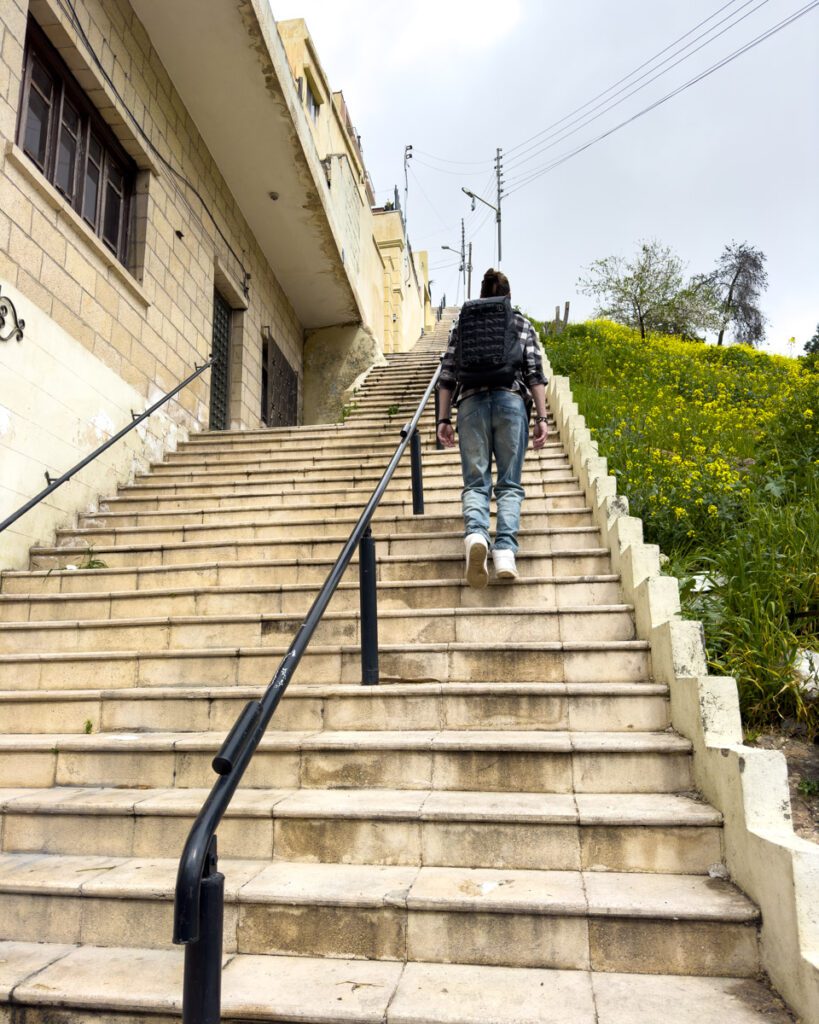
Taking taxis in Amman
Taxis are widely available in big cities in Jordan and Amman is no exception. They’re a convenient way to get around when you’re tired of walking up and down hills. You can either hail a cab (official ones are usually yellow) or you can stop one that honks at you while you’re walking around. Yes, you will get honked at very often in Jordan! Whether you’re driving or walking around – get used to it!
Uber is also available in Amman (and some other bigger cities). Careem is another ride-ordering option. Most rides in the city shouldn’t cost more than 2-3 JOD. You can either pay cash or by card. Just don’t be in a rush if you order a cab – many drivers are prone to cancel… but this is the case in many countries around the world.
If you take taxis off the street, negotiate your fare before starting your journey. Since all the attractions are close by, they should be fairly short rides.
Taking public transportation in Amman
Jordan has an extensive public bus network. It connects major cities and towns. And of course, Amman has its own network too. However, we didn’t take it.
It was much easier to get around by foot or to take cabs around. If you do want to take public transportation in Amman, we recommend asking the locals at your hotel.
Taking private shuttles and guided tours in Amman
Another option for getting around Amman is to take private shuttles or go on guided tours. In fact, there are plenty of options for tours that take you on day trips around Amman. With these tours, you can visit some amazing places like Jerash, Umm Qays, the Desert castles, As-Salt and even the Dead Sea.
This is a great way to take the hassle out of driving around and you’ll get a lot more information about the places you visit with a knowledgeable guide! You have plenty of options of guided tours in Amman available on Viator or GetYourGuide.
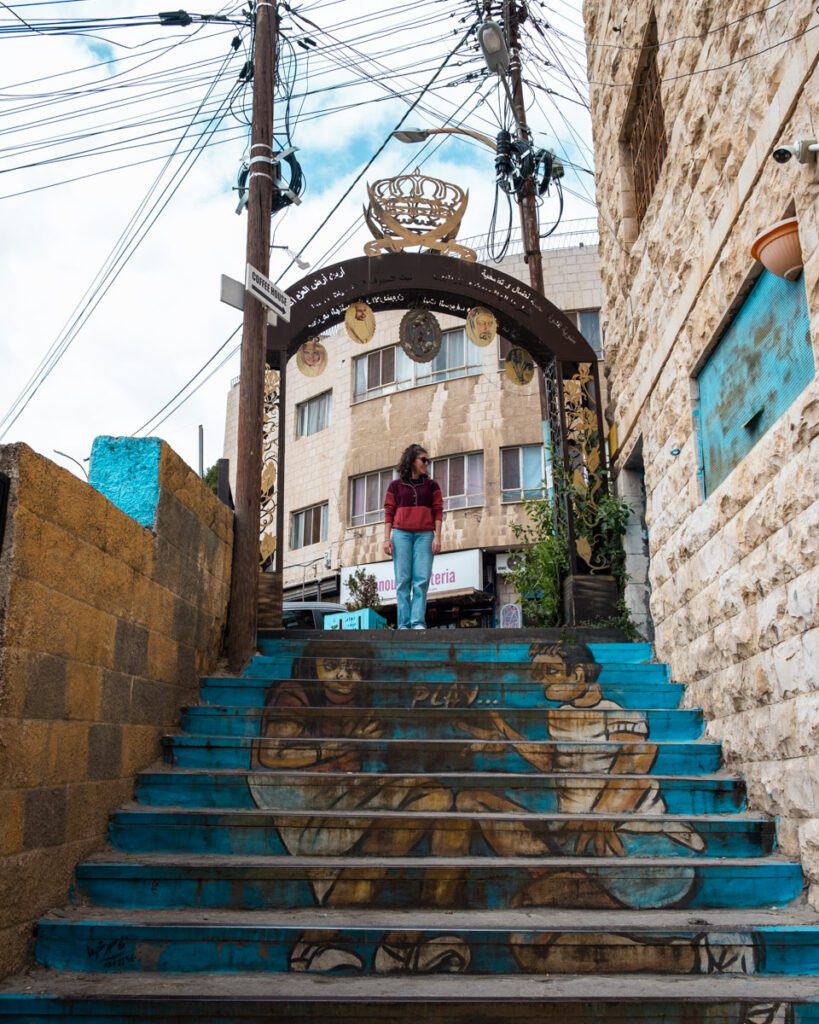
The best time to visit Amman
When you choose to visit Amman will depend on many factors, but if you’re looking to escape the crowds and have good weather, here are some things to know:
Amman is great to visit in the spring and autumn when the weather is mild. From March to May, and then from September to November, temperatures are pleasant which makes exploring Amman very enjoyable.
If you’re there in early March like us, you can expect a few rainy days, as well as strong winds throughout the country. Nights tend to get quite cool in March, so bringing warm clothing and dressing in layers is a must, regardless of the time of day. It may be warm in the sun, and very cold in the shade. Plus, in Amman, we had very quick shifts in temperature and weather. From sunny mornings to torrential rain at noon to colder afternoons. Have an umbrella or raincoat handy!
If you plan on visiting Amman in the summer, from June to August, expect very hot temperatures. In the winter, from December to February, temperatures drop quite low. Bring your winter clothes!
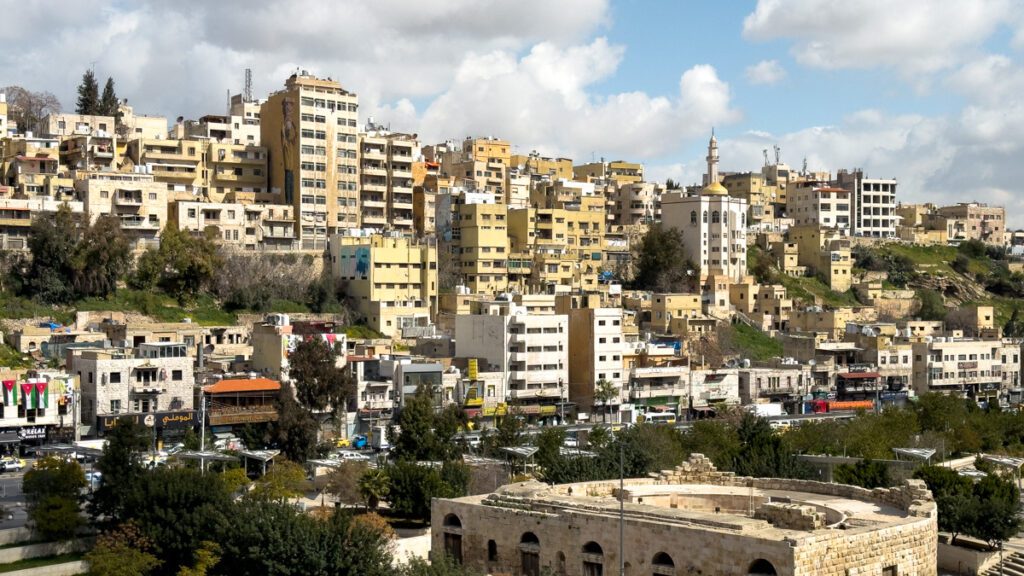
Everything you want to know about visiting Amman
When it comes to traveling to Amman, there are several common questions that visitors often ask. Here are some of the most frequently asked questions and our answers to them.
Is Amman worth visiting?
Absolutely yes! Amman is very much worth visiting. Not only is it beautiful and vibrant, but it has such a long and rich history.
We know many people come to Jordan and skip out on Amman. We had the luxury of having 18 full days in Jordan, so we really got to take the time and explore the city over 2 full days.
How many days to spend in Amman?
We recommend taking at least a full day here. It will allow you to see the main highlights and get a bit of a leg workout in.
But if you have the chance, we highly recommend taking 2 full days in Amman. This is what we did and it was the perfect amount of time to explore the city. It gave us a chance to take in all the main sites (and then some) and to truly immerse ourselves in this ancient capital city.
The 2-day itinerary we laid out above is identical to how we spent our 2 full days in Amman.
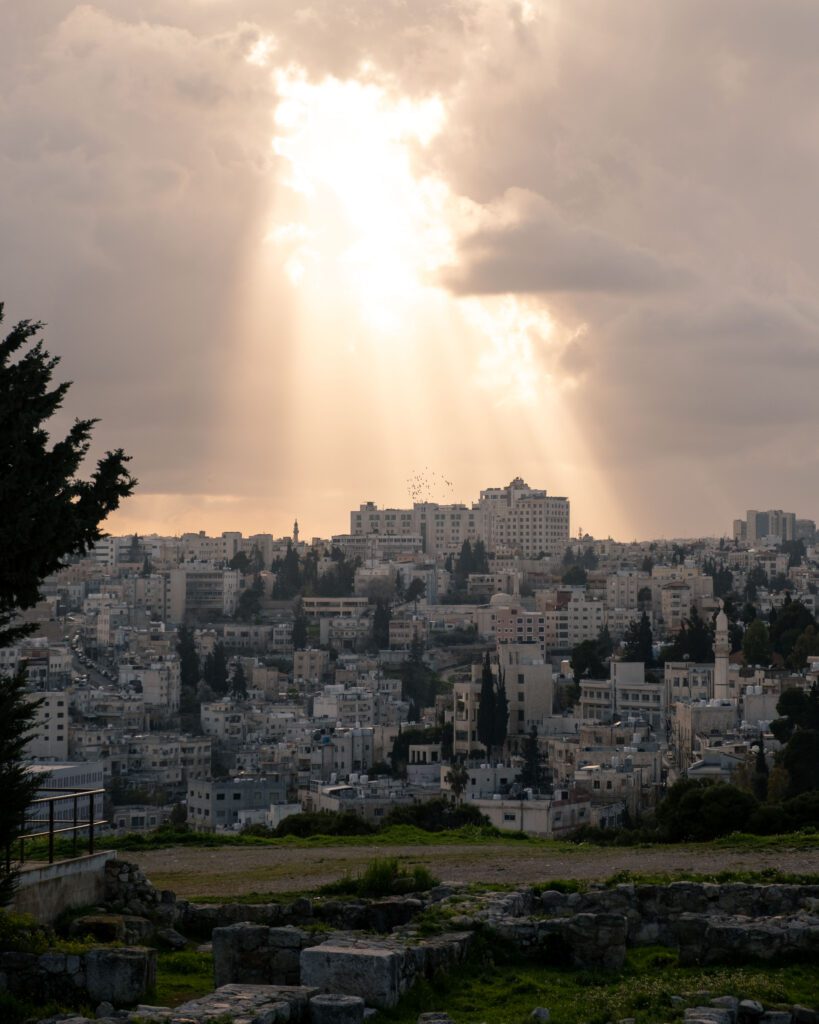
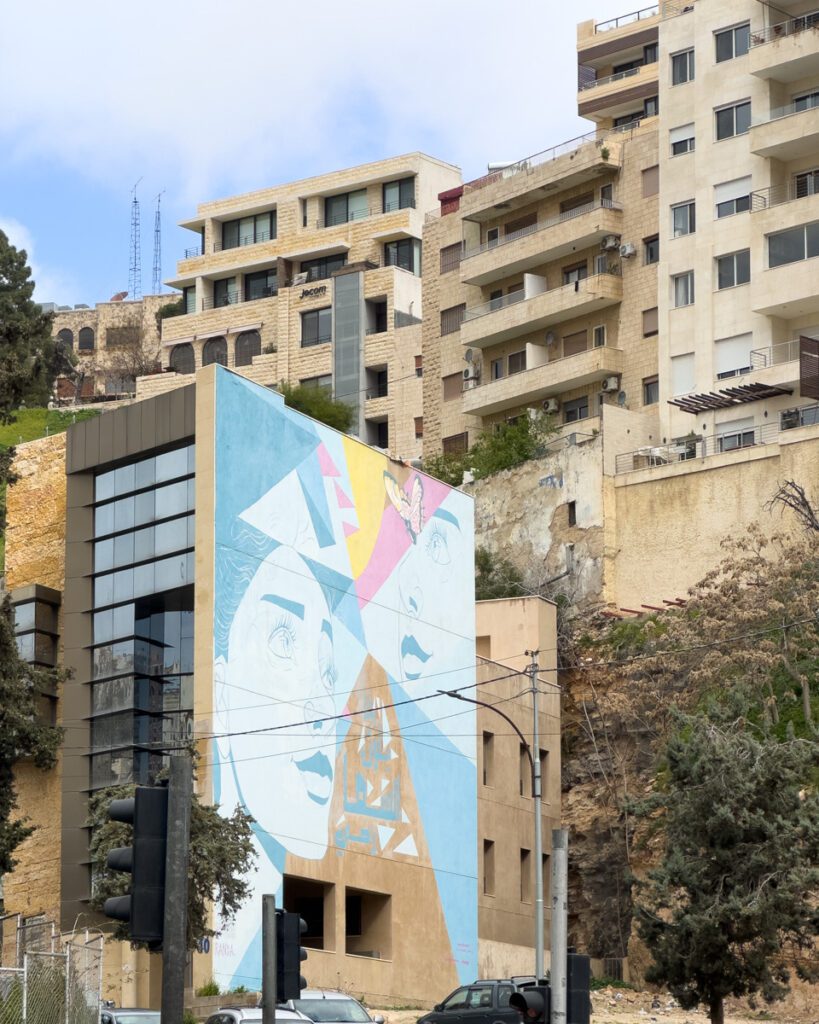
Is Amman safe for tourists?
As always, safety is a top concern for all travelers going to a foreign country. And to be honest, Amman felt completely safe to us. We stayed downtown and walked around at night, albeit not too too late, and we found that the city was very safe.
In fact, we’ve often felt safest in Muslim countries. People have always been very respectful and helpful and kind. Amman was no different.
Of course, petty crime may still be possible. And as always, when traveling, you should be aware of your surroundings and what’s happening around you. But overall, we felt like Amman was a very safe city.
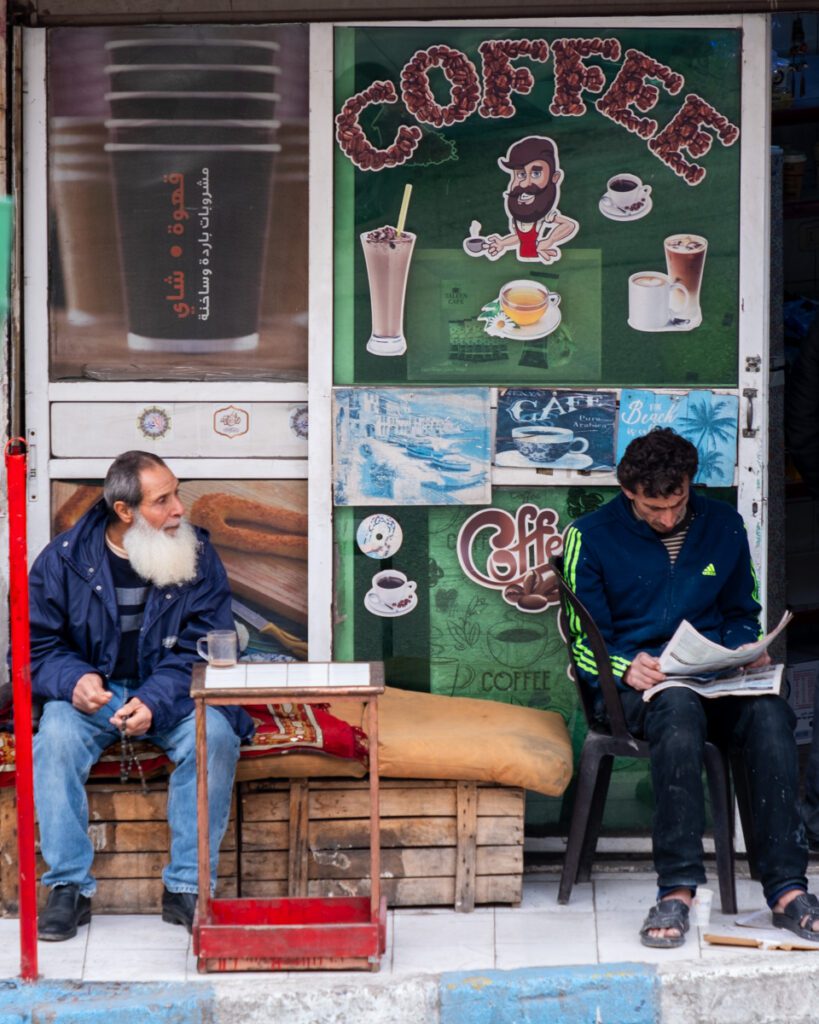
What should I wear in Amman?
We visited Amman in early March, and our best advice is to dress in layers and to have a raincoat or umbrella handy. We were also sure to be respectful of cultural norms and traditions in this Muslim country.
For men, we would recommend wearing T-shirts or long sleeves (depending on when you go), and avoiding tank tops. It also seems like men here didn’t really wear shorts. If you’re going in the hotter summer months, we recommend wearing lighter fabrics like linen or cotton. If you really run hot, and feel like you need to wear shorts, go ahead.
As for women, since this is a traditional Muslim country, we recommend dressing more modestly. Round-neck t-shirts, loose-fitting pants or long skirts and great options. Carine avoided wearing anything too form-fitting and showing off her shoulders. Plunging v-necks should be avoided too. You don’t need to wear a headdress but it helps to have a shawl with you if you need to modify your outfit.
Locals know you’re a foreigner, and they won’t give you a hard time for what you’re wearing. Of course, the choice is always yours as to if you want to dress modestly or not. We prefer respecting local customs when they don’t require such drastic efforts as it’s a simple sign of respect and gratitude for a country that has welcomed us.
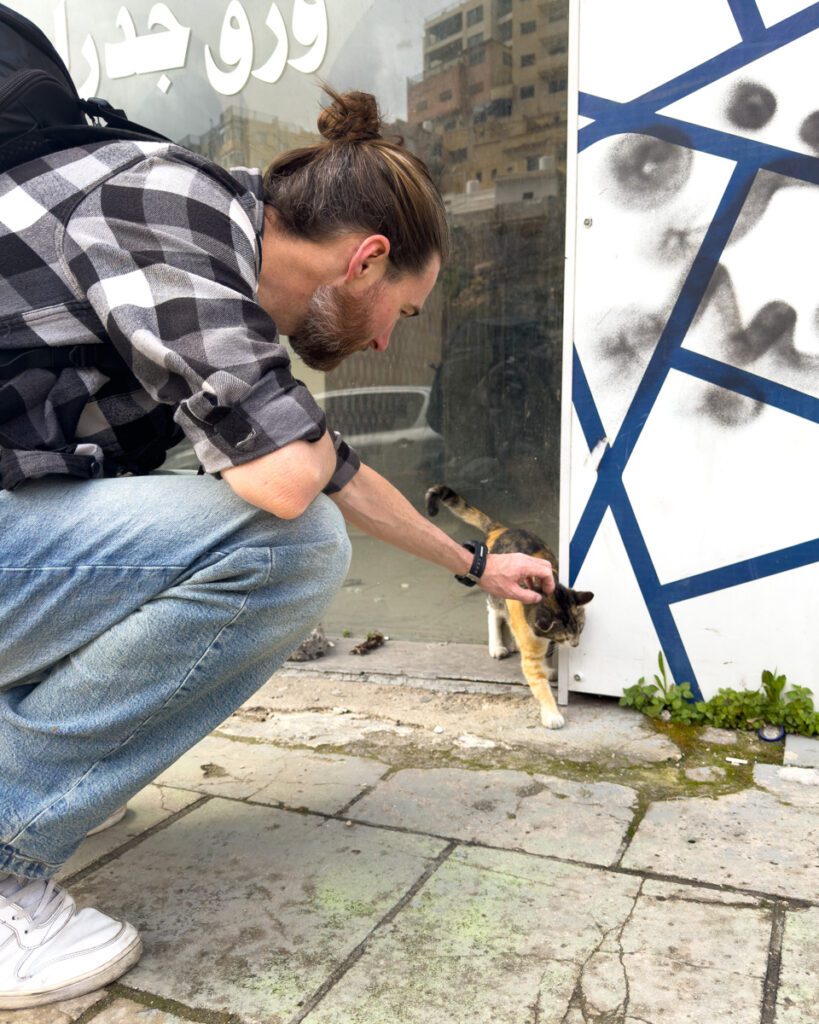
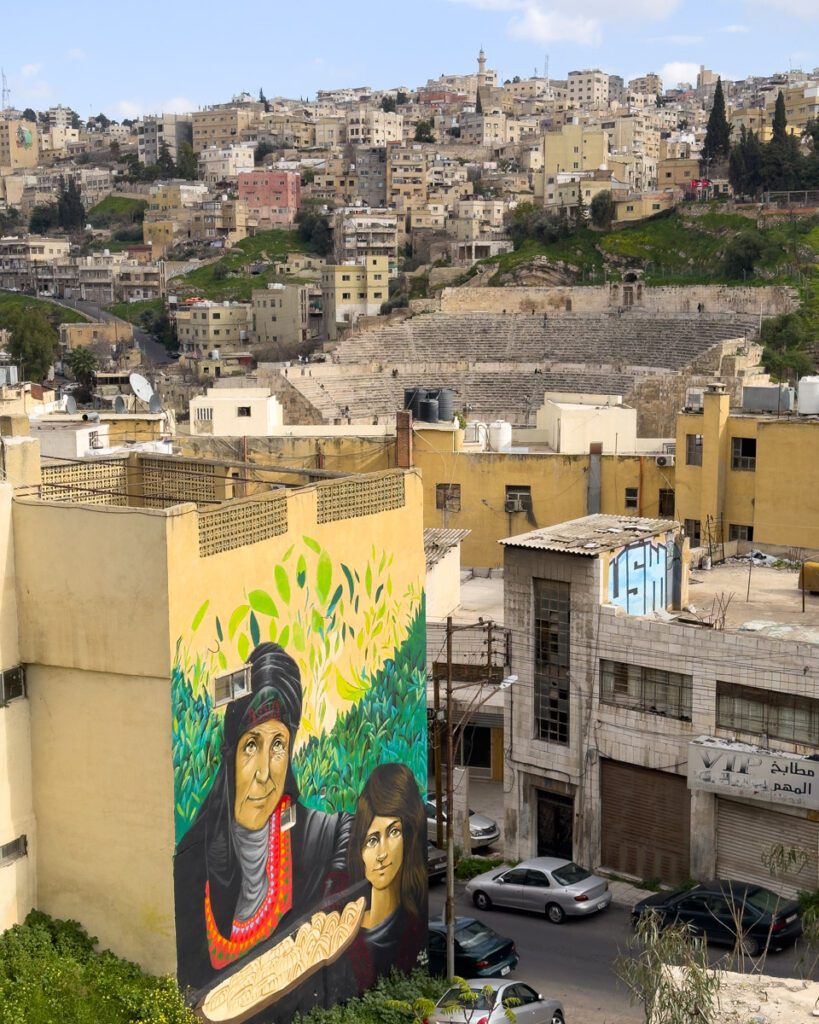
What currency is used in Amman?
Jordan has its own currency called the Jordanian Dinar (The locals say JD, but it is officially written JOD). And unfortunately for foreign travelers, it is a very strong currency!
You can check out the currency exchange here.
One thing we would recommend you watch out for is the amount of bank fees. Usually, most banks will charge between 3-5 JOD. This is a huge amount, especially if you only want to pull out a small sum. The best banks to use to avoid fees are Jordan Kuwait Bank & Arab Bank.
As for exchanging your money, we would recommend avoiding the Exchange desk at the airport. Instead, find the Musharbash Money Exchange or the Alawneh Money Exchange (They have many spots around Amman). They had better rates.
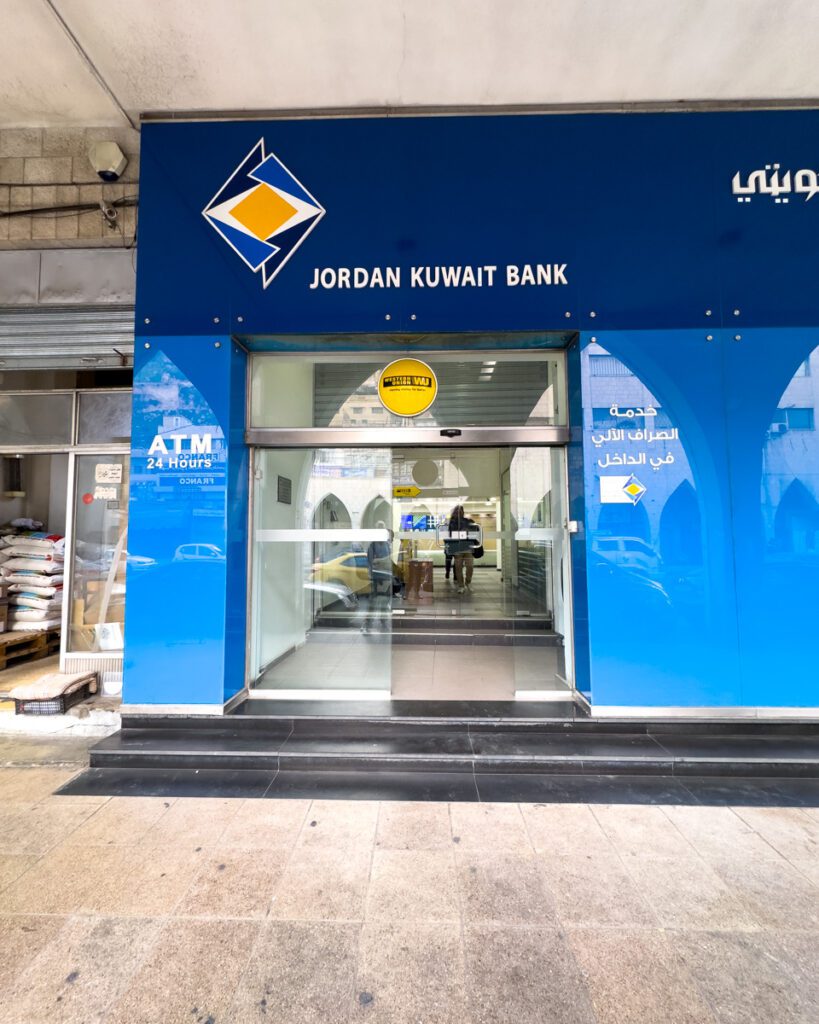
Do I need a visa to visit Amman?
This is a tricky question to answer, as it depends on which country you’re from. Most international travelers are able to get a visa on arrival and have the fees waived with their Jordan Pass (which should be purchased before coming to Jordan).
Most people from Arab nations do not need a visa, as well as some European, North & South American travelers. These are the countries that don’t require a visa to can get one on arrival:
- European countries, except Albania and Moldova, can get a visa on arrival
- North American countries, except Belize and Cuba, are eligible to get a visa on arrival
- South American countries, except Columbia, are eligible to get a visa to Jordan on arrival
- Bahrain
- Egypt
- Kuwait
- Lebanon
- Oman
- Palestine
- Qatar
- Saudi Arabia
- Turkey
- United Arab Emirates
Many travelers from countries in Asia & Africa cannot get a visa on arrival. We would recommend you check with your government and see if you need a visa before arriving to Jordan.

What language is spoken in Amman?
The main language that is spoken in Amman and Jordan as a whole is Arabic. However, since tourism is a big part of the country’s income, many people working in the service industry speak English. You’ll even find some people speaking a bit of French, Spanish or German. Many times, they are the typical phrases used for their job, but they all love showing off their skills.
If you can, it is advisable to learn a few words of Arabic to help build a nice connection with locals. As in most countries, the people of Jordan enjoy seeing travelers speaking Arabic. Here are a few words you can use:
- Na’am (naäam) – Yes
- Làh (Laa) – No
- Min faDlik – Please
- Shukran – Thank you
- Äafwan – You’re welcome
- As-aalaam alaikum – Peace be upon you
- Commonly used as a greeting when meeting people.
- Lazeeza – Delicious
- They love it when you say this after a delicious meal in a restaurant.
- Insha Allah – God willing
- You will hear this a lot. Sometimes, when they don’t want to directly say no, they will say Insha Allah. We took it as “We’ll see, but probably no”.
Where to eat – Vegan-Friendly restaurants in Amman
Since Carine is vegan, we often only go to restaurants that are vegan-friendly. Luckily, in Jordan, there are plenty of dishes that are accidentally vegan. From mains to salads to sides, there are a ton of delicious, healthy and vegan-friendly dishes to choose from.
Here are some of the best restaurants we enjoyed during our time in Amman.
Bayt Sara for vegan food in Amman
Bayt Sara means Sara’s House in Arabic, and get ready for a cozy welcome and a delicious meal! And if you’re a cat lover like us, this is the place to come!
We came to Bayt Sara for supper as recommended by the staff at our hotel. The owner is not vegan and he swears this is some of the best food in Amman. He was right! The small restaurant only seats about 10-12 people, which makes for a warm and welcoming atmosphere.
Sara is an energetic and charismatic owner who will greet you and explain the menu. Every dish is made daily and the menu changes based on what’s available. All dishes are 10 JOD, which is more expensive than most places, but the portions are huge. Perfect for sharing, or saving for lunch the next day.
While we were there, we tried the vegan shawarma – it was flavorful, juicy and delicious. It came with a side of pickles and some homemade mayo that was absolutely amazing. You couldn’t tell these were all vegan! We also had some Romanian crepes – thin pancakes stuffed with imitation minced meat, and drenched in a tasty tomato sauce. Absolutely amazing.
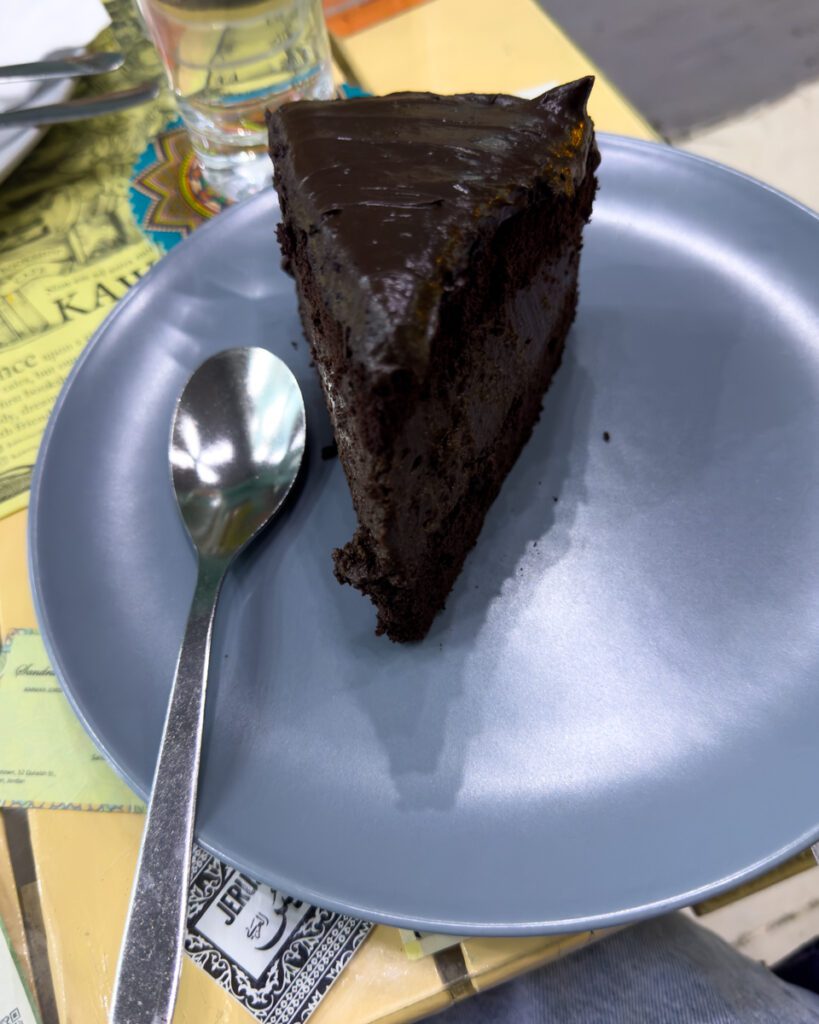
We, of course, left room for dessert – a decadent chocolate pudding cake. It was scrumptious. At first, we weren’t sure we’d be able to finish this piece of cake since it was so enormous (we’re not exaggerating, it might have been the size of Carine’s head), but after taking one bite, we couldn’t stop eating it!
If you have the chance, whether you’re vegan or not, we would recommend stopping by Bayt Sara for a meal. When we were there in March, she was planning on opening a vegan supermarket next door. If you go, let us know if the shop is open. Stock up on the goodies you can bring with you!
Sara is also an activist. She takes care of 160+ cats in Amman and even runs a shelter in Petra to help with the camels and donkeys who are there (and who are often mistreated). If you can spare a few JOD, make sure you donate to her worthy causes.
Rakoon for delicious Indian food loved by locals
If you’re like us, you might not be able to refuse Indian food, even when traveling. And sometimes, it’s nice to take a break from the typical local food to have something different. Plus, as vegans, we know there are always some plant-based dishes we can easily find at Indian restaurants.
While we were out exploring Rainbow Street, we came upon Rakoon, an Indian restaurant. We were later told by locals that this is the best Indian restaurant in Amman, and we could totally believe them, The food was delicious.
Although there isn’t a big atmosphere in the restaurant, the food is authentic, fragrant and mouth-watering. You can choose how spicy you’d like the dish, which is great if you don’t have a high tolerance. We love spicy Indian food and found the medium to be just enough kick. It builds up, so don’t be fooled if you don’t find the first few bites spicy!
Derek loved this Butter chicken, and Carine was a big fan of the Aloo Mutter. Make sure you tell them if you’re vegan as some dishes may have ghee.
If you’re looking for a break from Middle Eastern cuisine, Rakoon is a great choice.
Hashem for cheap and traditional meals
Hashem is the restaurant locals and foreigners will tell you to try in Amman. And we can see why. Eating here is quite an experience. The food is good cheap and the restaurant is conveniently located downtown.
Walking into Hashem, we got kind of confused… there are tables all around, some doors and entrances to what seems to be other restaurants, people walking around, waiters with large trays balancing many dishes at ones… just confusion!
The way this works is that you walk in, take a seat a table you want and the waiter brings comes to set up the table then tells you what they have. It’s a simple menu (and he’ll show you the little paper (but without any prices). Don’t worry, nothing is expensive here. Think local prices!
We had a ful dish (beans with garlic), hummus with meat, french fries, pita, a dish of pickles and veggies (this comes standard no matter what you order), tea and the total was a whopping 5 JOD. Not bad at all.
The dishes were hearty and flavorful. Don’t expect much from the service – some of the waiters were. a bit rude, but some also joked around. Luck of the draw!
If you want a no frills local meal, this is where you should eat.
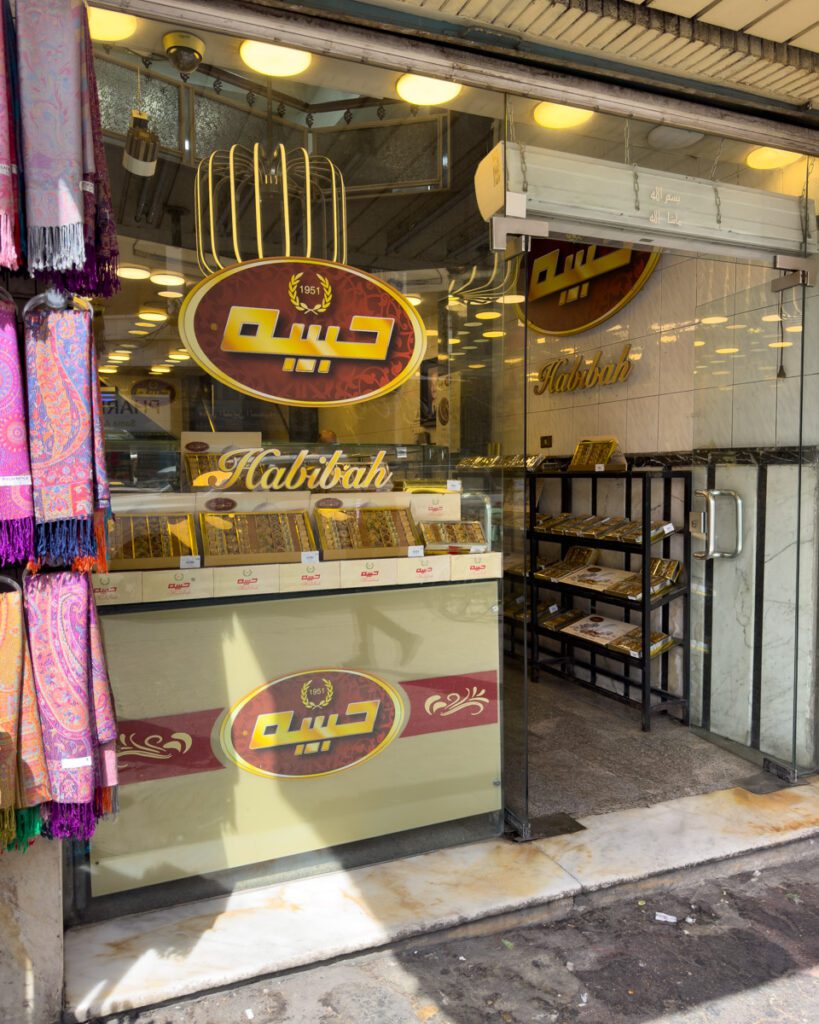
Habiba for sweets adored by locals in Amman
Another name that came up many times by locals was Habiba. And their exact words were always the same: “You have to try kunefe”. Even though Carine can’t have it anymore, she grew up on the Lebanese version of Kunefe – a sweet dessert dish made of melted cheese. It’s topped with a pastry or shredded wheat topping, then drenched in sweet syrup.
It might sound weird but it’s delicious. We highly recommend you try it. Derek did and it was one of the best ones he had in Jordan!
Habiba also serves other traditional Middle Eastern dessert dishes, from baklava to cheese fateer and cream hareesa, you’ll find all the Middle Eastern favorites here.

For our plant-based friends, there isn’t much to have here. They did have one little baklava that was made with simple syrup, with no dairy, so that’s what Carine had.
But for non-vegans, this is the place to go to satisfy your sweet tooth.
Wild Jordan Center for beautiful views & vegan options
We mentioned Wild Jordan as a great option for places to catch a stunning view of Jordan. It’s also a great place to grab a drink or a bite, especially if you want to have a plant-based meal… or not, they have a ton of options for everyone.
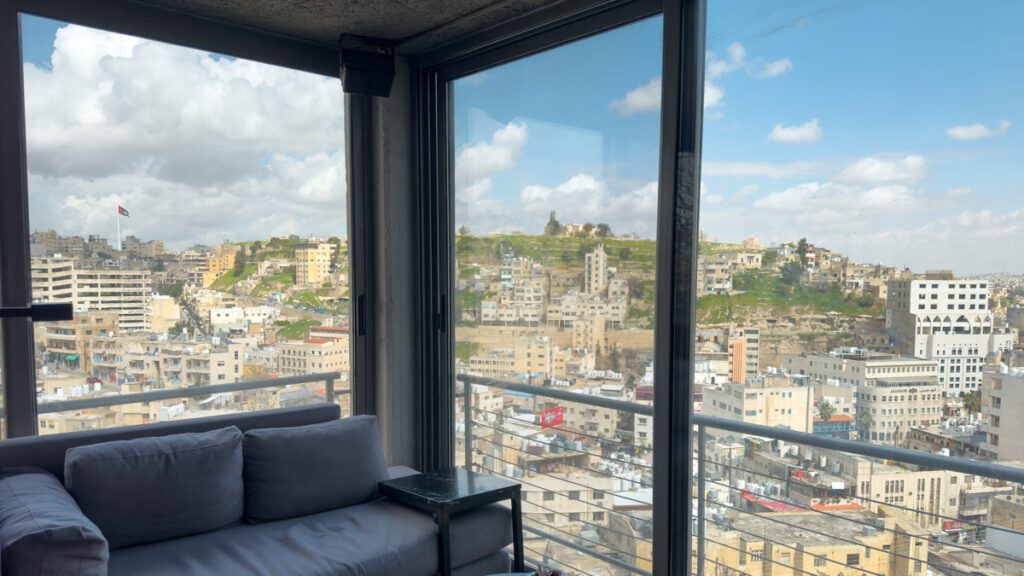
Pick the table with the best view and enjoy what’s about to come. We tried the lentil soup which was flavorful and hearty, with a hint of lemon and toasted bread. Derek had a halloumi cheese and tomato sandwich, while Carine had an avocado sandwich with homemade pesto. Both were huge in size and very delicious.
Although the prices here are more expensive than at local restaurants, you can eat in peace knowing you’re contributing to the local communities. Wild Jordan is owned and operated by the Royal Society for the Conservation of Nature. The center helps create an income for the rural communities in its 8 reserves across Jordan.
You’ll notice the Wild Jordan Center also has a co-working space, a bar and a shop where you can buy locally handmade products. Proceeds from the Nature Shop generate income for the families of the reserves.
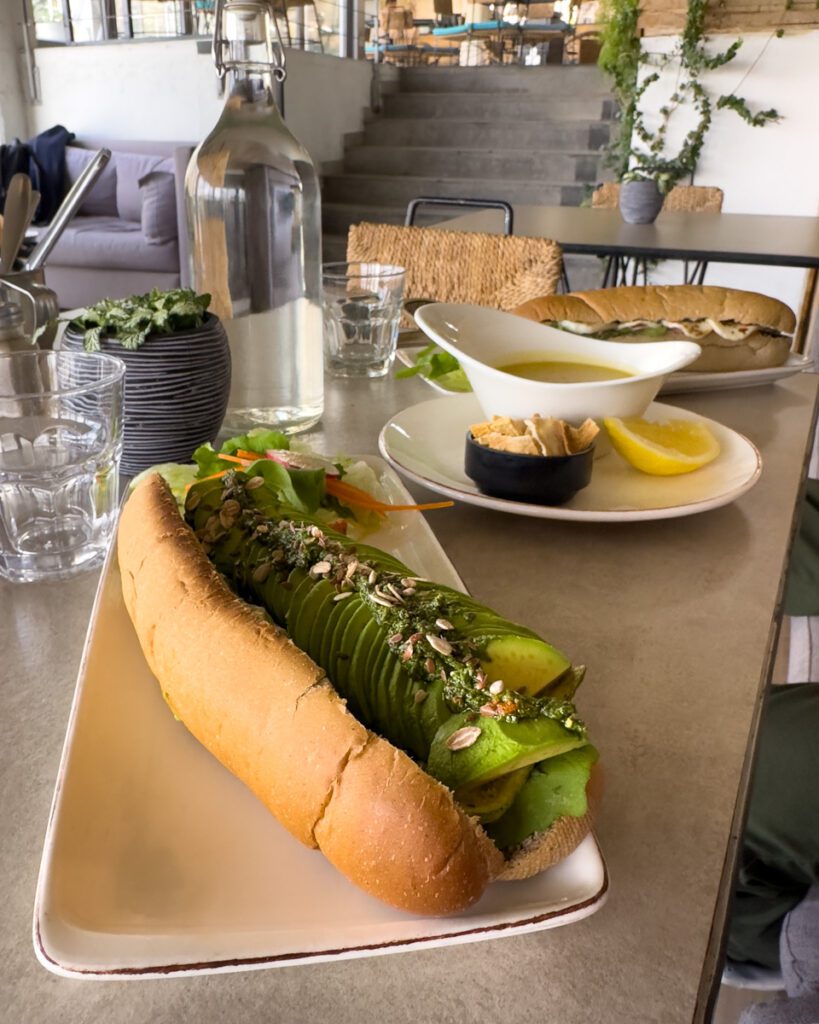
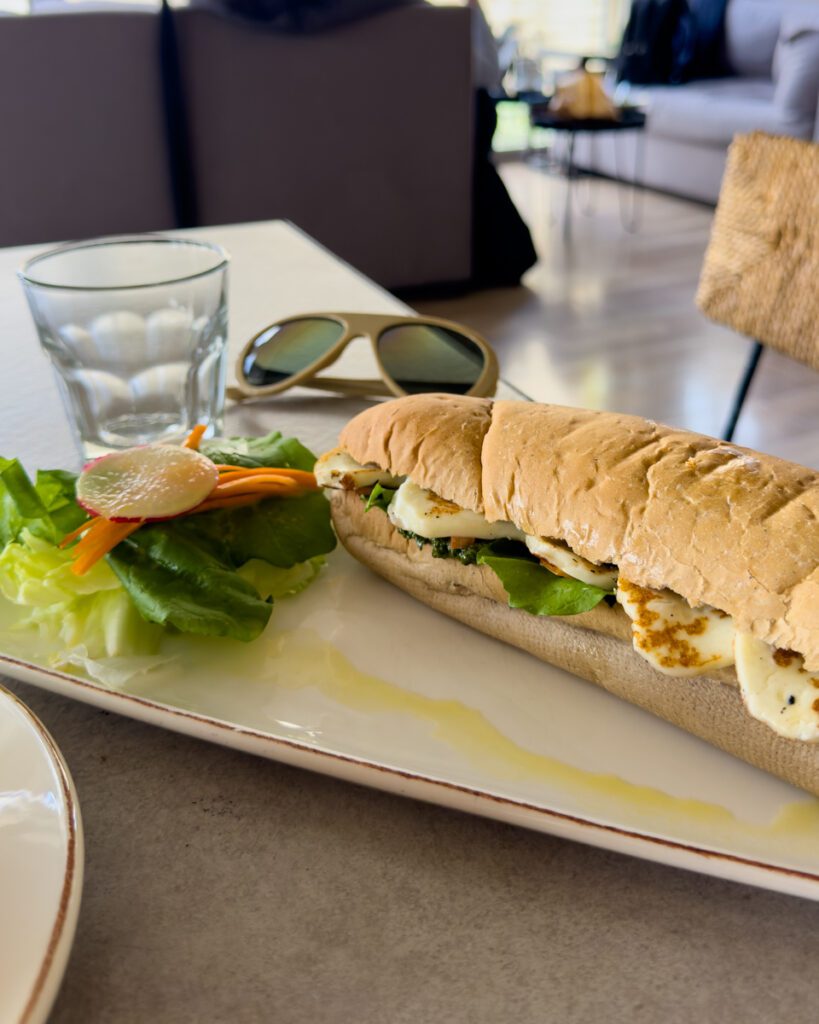
Other delicious restaurants to try in Amman
In 2 days, we ate as much as we could, but not enough to try all the places we were recommended. Here are some other restaurants that came with high praise from locals. Some may have vegan options, while others don’t. If you have dietary restrictions, make sure you inquire before going or ordering.
- Alquds – Perefect for traditional Jordanian cuisine. Known for their Mansaf dish (Lamb in a yogurt sauce). Location on Google Maps.
- Shahrazad – More for grilled BBQ-style Middle Eastern cuisine. Location on Google Maps.
- Sara Seafood – The name says it all. If you’re craving fish, head here. Location on Google Maps.
- Abu Hatem – Another option if you’re looking for BBQ – think shawarma, kebab and more. Location on Google Maps.
If you find other delicious restaurants in Amman, let us know. We’d love to update the list.
Where to stay in Amman
We chose to stay in the downtown area. Since we love to walk and we wanted to be close to all the attractions, we picked the Sandra Hotel as our home for the 3 nights we spent in Amman. We would highly recommend staying here for many reasons.
As we mentioned, the hotel was perfectly located – we were within walking distance of all the best attractions and restaurants in the city center. However, since Amman is built on seven hills, even if distances seem close, they will all have an incline. Be ready to get a workout in!
Sandra Hotel also provides a delicious breakfast. Every morning, we would get up to a little buffet of falafel, hard-boiled eggs, pita, bread, jams, olives, tomato, cucumber, oranges, some cold cuts and cheeses, and so many other delicious dips. It was the perfect way to fuel up for the day of exploration to come.
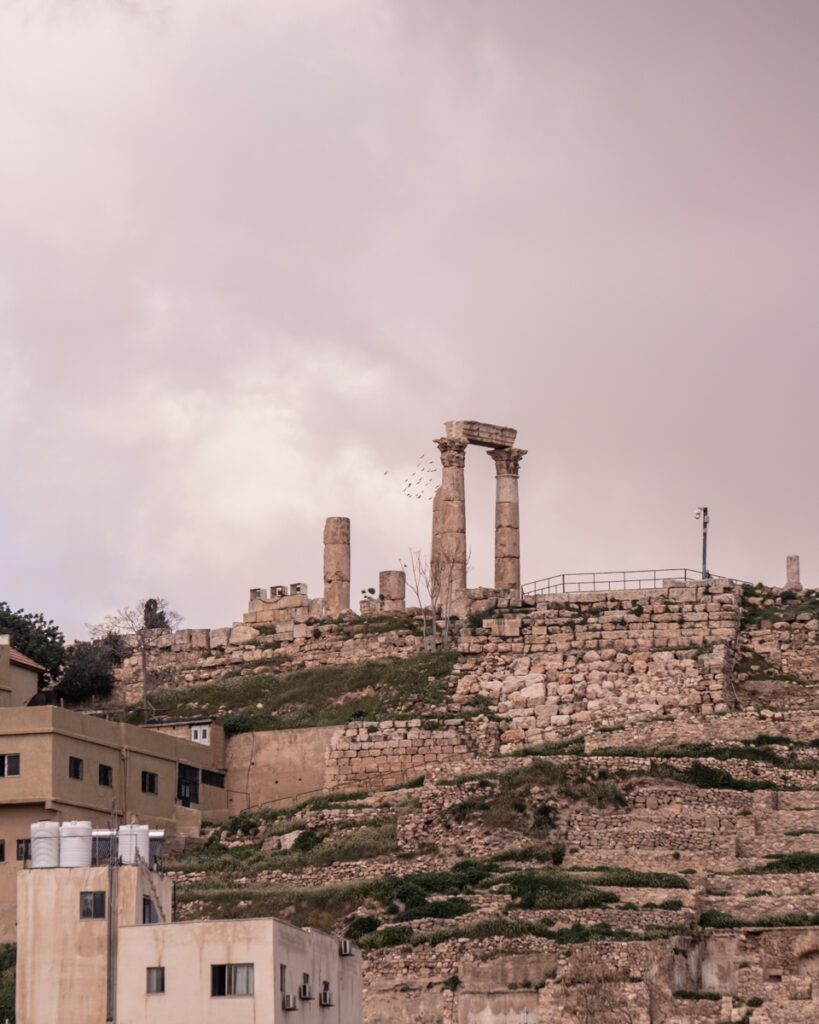
The room we had was spacious and the bed was super cozy. Since you are in the heart of downtown, expect to hear noise from the street below, but you should be fine at night when traffic subsides.
All pretty standard for now… but what really made the difference at Sandra Hotel is the staff. Each person who worked here had a real passion for helping the travelers make the best of their time in Amman. They were happy to help you plan your days around the city but also had a ton of great recommendations when it came to exploring the rest of the country. In fact, we changed our itinerary around quite a few times thanks to all the information they gave us! Everyone at the hotel was super sweet and helpful and made our stay so much better!
If you’d like to explore other options for accommodations in Amman, here are the best-rated hotels and hostels:
- Hostels: Carob Hostel. Sydney Hostel. Nomads Hostel.
- Budget accommodations: Dali House. Beirut Hotel. Arab Tower Hotel.
- Mid-range hotels: The Castle Star. Nu Fifty Two. Amman Trail Hotel & Studios.
- Luxury hotels: The House Boutique. New MerryLand Hotel. Lemon Tree Residence.
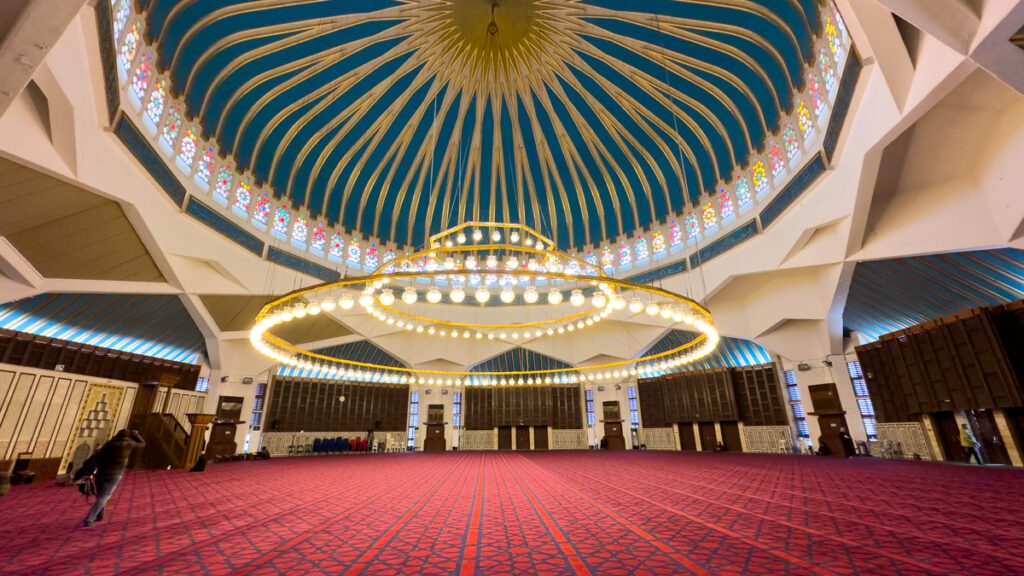
Top 16 things to do in Amman
There you have it! The 16 best things to do in Amman, as well as your 1 or 2-day Amman itinerary. As a reminder, here is a quick list of all the best attractions in Amman:
- Amman Citadel
- King Abdullah Mosque
- Darat al Funnan
- Explore the street art
- Roman Theater
- Nymphaeum
- Duke’s Diwan
- Visit a souk
- Hang out on Rainbow Street
- Take in the views at the different viewpoints
- Check out the Jordan Museum
- Go on a day trip from Amman
- Join a cooking class
- Go shopping at Abdali Mall
- Visit the Automobile Museum
- Check out the different art galleries
We hope that this article will help change your mind about skipping out on Amman (we really recommend a visit here). And that our tips will help you plan out the best itinerary for your trip.
Let us know in the comments which Amman attraction you’re most excited to explore. Are there other places we should be adding to the list? Did some of these places disappoint you? We’re always curious to hear about your experience, so don’t be shy.
Thank you so much for reading the article all the way through!
We put a lot of time and effort into the content we create. Please like, comment and share – every action on your part helps us out tremendously and is very appreciated.
You can also help us by pinning this article for others to find.
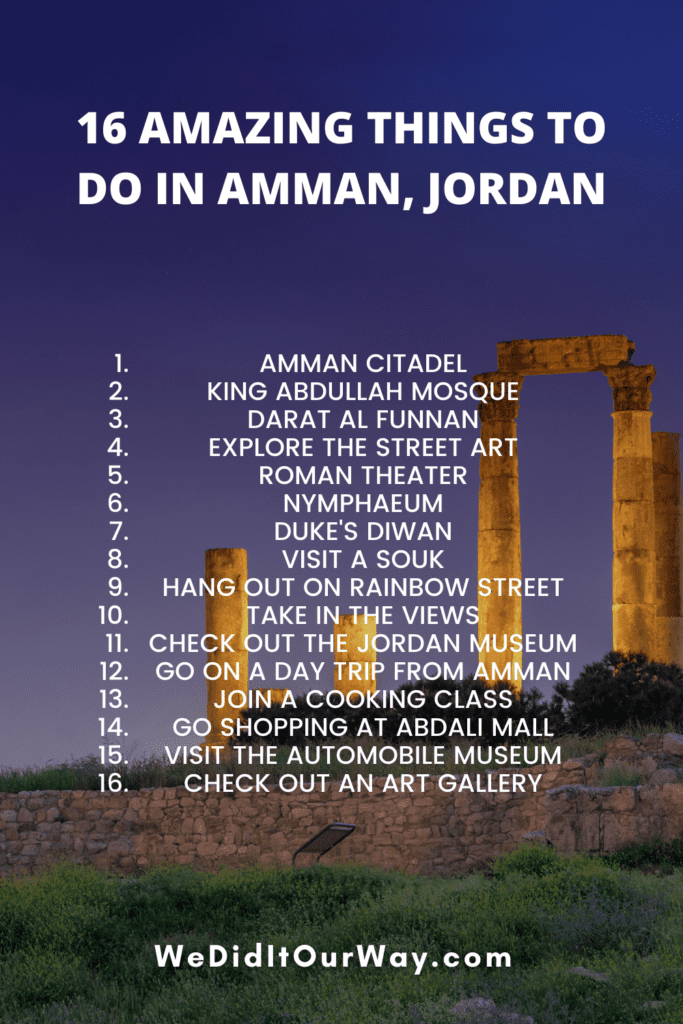
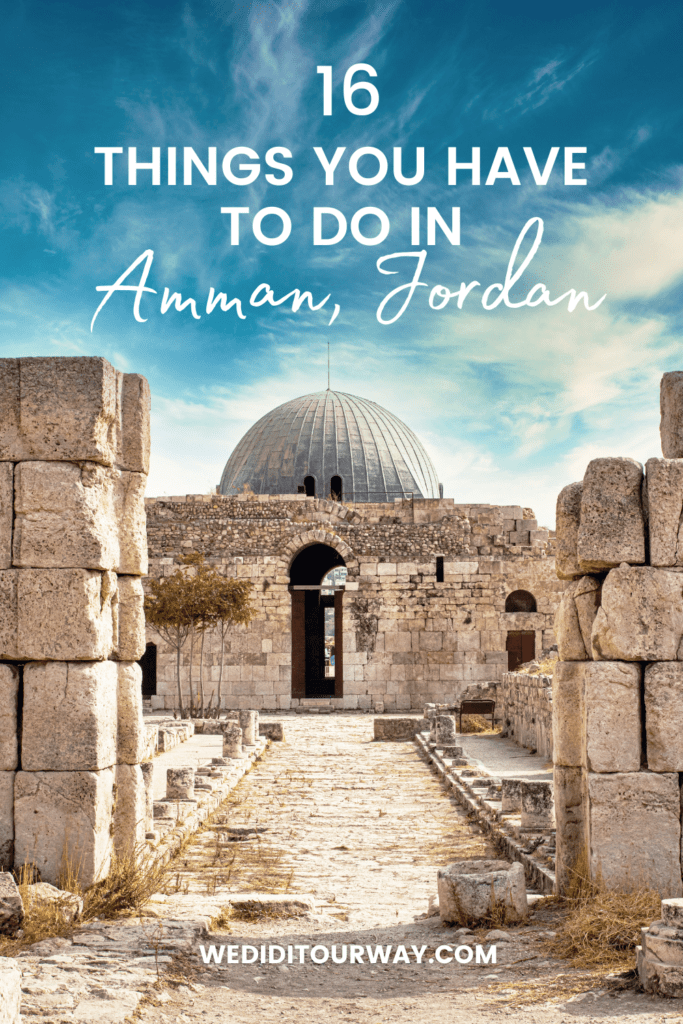
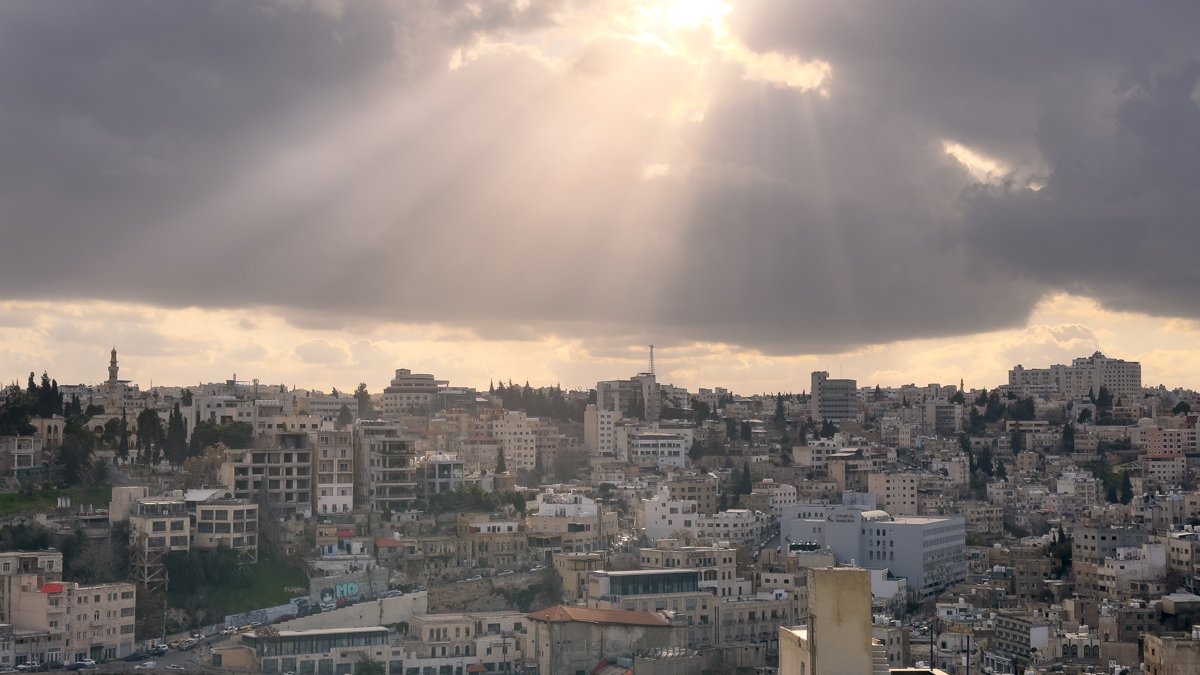

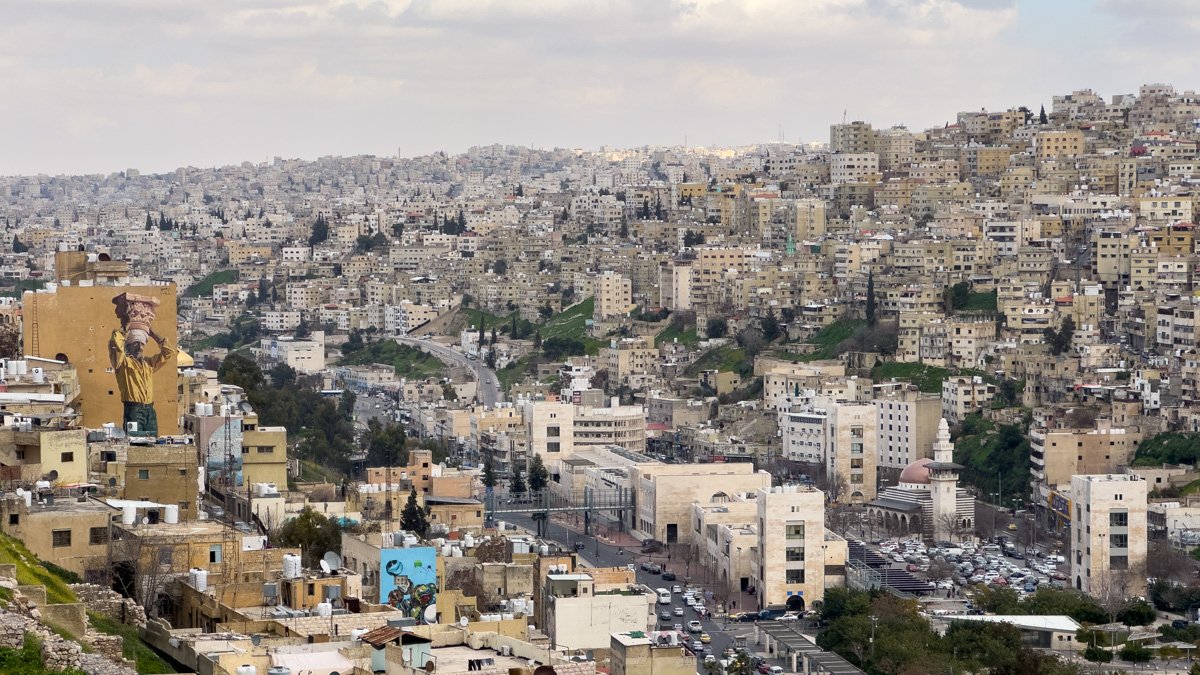
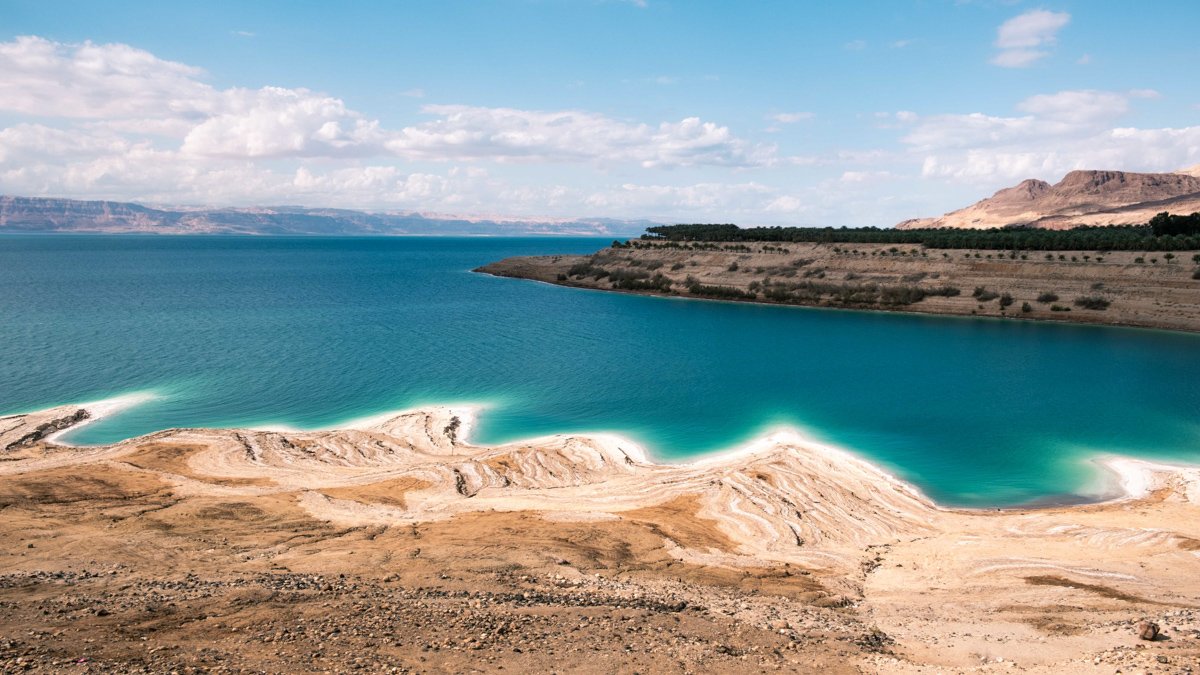
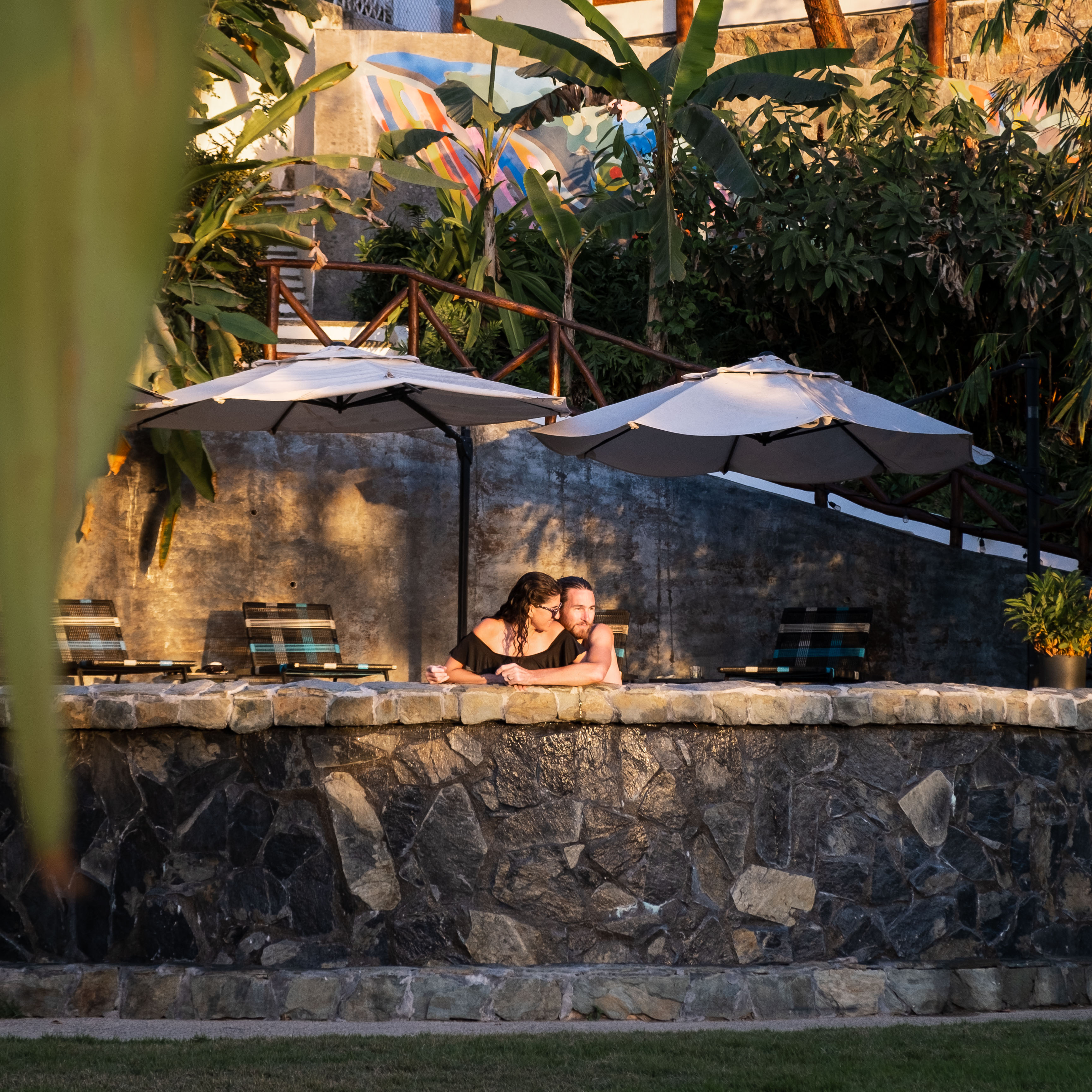


0 Comments